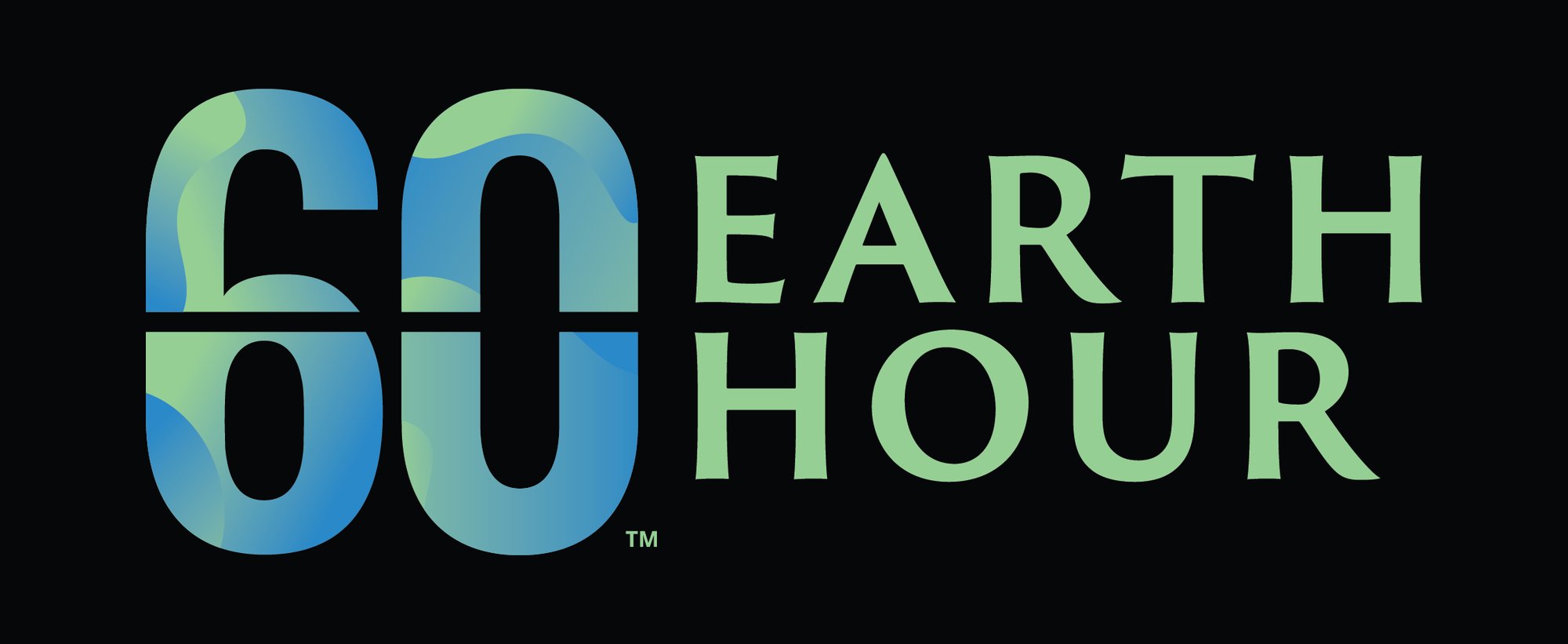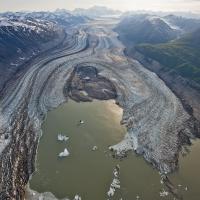
9 January 2016: The future of Earth rests upon us.
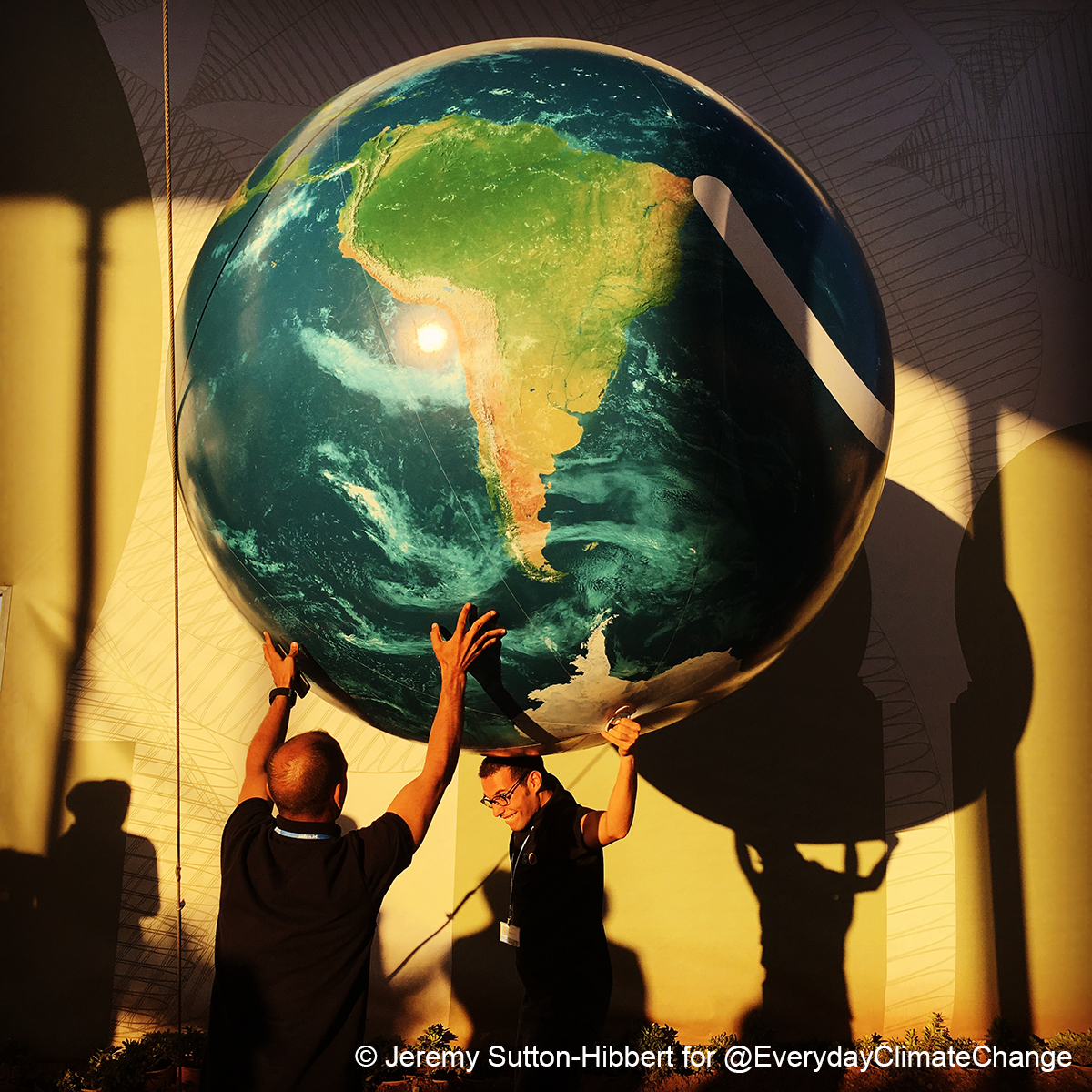
© Jeremy Sutton-Hibbert for @EverydayClimateChange [ Photo by @JshPhotog @GreenpeaceAR / @EverydayClimateChange]
As scientists attempt to determine if the Earth has entered a new era called the Anthropocene, where human activity is said to be pushing our planet into unchartered territory, the responsibility of securing the future of our planet rests on each and every one of our shoulders.
From habitat loss and degradation, to pollution, climate change and more, the threats facing the environment today present us with many challenges. In fact, global biodiversity is declining at an alarming rate, putting the survival of other species and our own future at risk :o In addition, the effects of climate change not only impact both livelihoods and communities around the world, but species both directly and indirectly as well.
In the face of these immense challenges, we have to remember that the solutions to build a climate-friendly future exist today. Whether it’s the need to transition to a future powered by renewables, producing and consuming more wisely, or redirecting our path towards one that is more sustainable, we have the means to alter the course of humanity and build a more secure future for the planet, its people and wildlife. Discover more here.
24 October 2016: A window into the world of global warming.
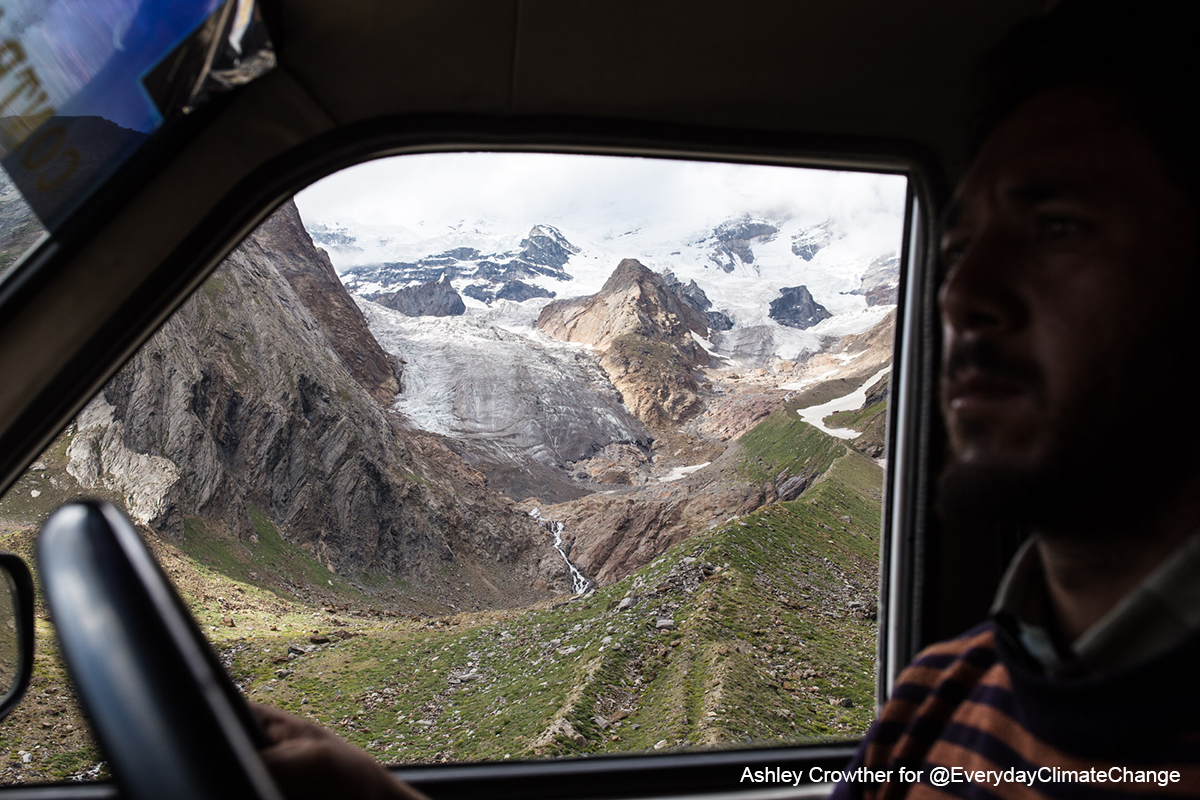
© Ashley Crowther (@ashleycrowtherorg for @EverydayClimateChange)
Photographed in the Himalayas, this image provides a window into the world of global warming and its effects. This majestic region is one of the world’s most sensitive climate hotspots, with many of its glaciers retreating at a rapid pace, putting its stunning landscapes and incredible biodiversity at risk. And while the Himalayas translates to ‘home of snow’ in Sanskrit, that definition may very well become obsolete if we don’t act to change climate change today :o
One of the most significant climate change impacts visible in the region is the formation of a large number of glacial lakes, which could lead to grave consequences to communities living downstream should the rubble dams holding back the waters give way.
In view of how heavily billions of people across Asia rely on these mountains, local communities in the Eastern Himalayas need to be equipped to cope with the increasing threats of extreme weather, as well as a better understanding of climateimpacts on river systems.
WWF works on the ground to help communities take protective measures against the impacts of a changing climate. Adaptation strategies at the community level, developed in close collaboration with the communities themselves, are designed to be locally suitable to help ensure people live in harmony with nature. Find out more about what WWF is doing to conserve this magnificent region.
10 October 2016: Shot in El Nido, Palawan, an outrigger banca approaches an idyllic bay on a limestone karst island.
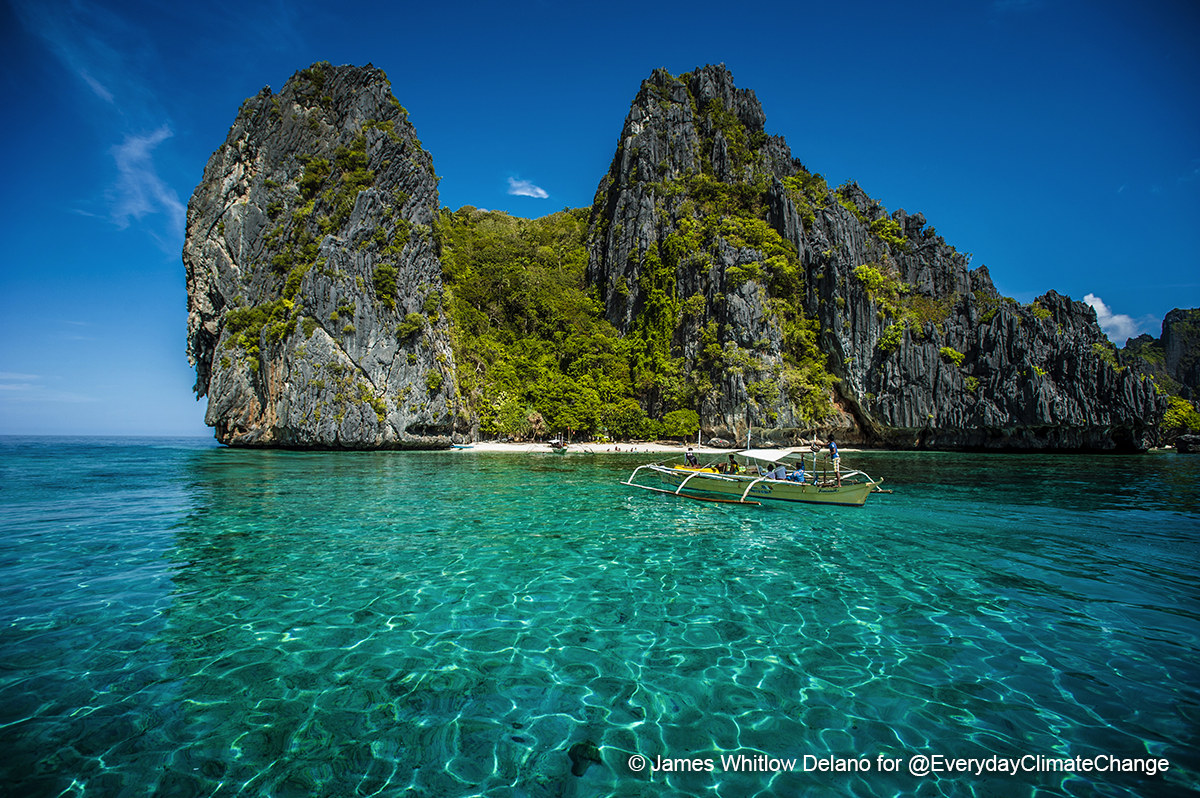
© James Whitlow Delano (@jameswhitlowdelano for @EverydayClimateChange)
Looking at this stunning image photographed in El Nido, the gorgeous view of the crystal clear waters of Philippines is a true exemplification of the beauty of this amazing planet that we all call home :) Unfortunately, climate change poses a serious threat to the magnificence of the country and its citizens, with the Philippines being ranked as one of the most vulnerable countries to climate change. :o
From typhoon Haiyan, to Thelma, Ike and more, the Philippines saw some of the deadliest typhoons between 1947 - 2014, with five occurring in the last decade alone. While the country has long been particularly vulnerable to extreme weather, the frequency of violent storms in the past decade has been attributed to climate change. In addition, the country’s geographic location in the Western Pacific Ocean is another factor that contributes to the threat of storms and extreme weather. Surrounded by naturally warm waters that will likely get warmer as sea-surface temperatures continue to rise, the ocean then releases some of its heat into the atmosphere, creating wind and rain clouds, which intensifies as global warming accelerates.
And while mangrove systems of the Philippines act as a buffer against typhoons, almost half have disappeared since 1918 due to deforestation - highlighting the fact that everything in our planet and its ecosystems is connected! From curbing deforestation, to shifting to a future powered by renewables and more, there is so much we can do together to combat the worst effects of climate change - which we witnessed through the recent news of the Paris Agreement entering into force :)
27 Sep 2016: Tea pluckers in Mogulkata Tea Estate, Dooars region, West Bengal, India.
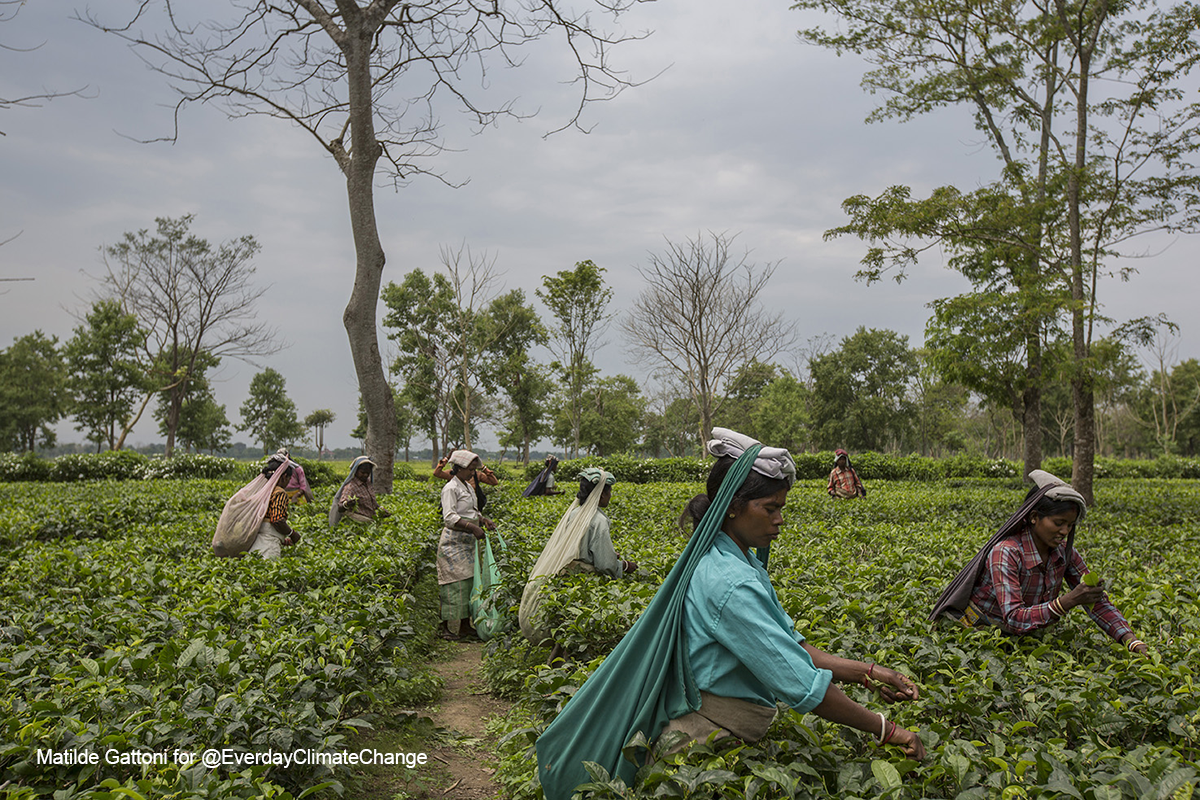
© Matilde Gattoni (@lucforsyth for @EverydayClimateChange)
Looking at this photo, we bet you’re already looking forward to your next fragrant cup of tea ;) And whether it’s the morning cup of coffee or tea we can’t do without, or a cold glass of orange juice to quench our thirst, for many of us it’s easy to take the everyday food items we have for granted. Oftentimes, the entire phenomenon of climate change might seem distant, with many of us unintentionally holding onto the misconception that the impacts of climate change are happening ‘over there’ and not directly to us - but changes in weather conditions and extreme weather events such as heat waves, droughts and floods are already causing losses in yield of many agricultural commodities.
In fact, depending on the degree of global warming and our capacity to adapt, the negative impacts of climate change will likely increase in the future, and climate-related changes could cause crop failures in many agricultural products. This means consumers across the world will start experiencing the effects of a changing climate in their very own supermarkets, where the availability and/or cost of agricultural commodities like coffee beans and oranges will be affected :o To find out what climate change could mean for our favourite commodities, check out WWF’s ‘The Calm Before The Storm’ report.
Now more than ever, urgent climate action is needed to secure the future of our planet and generations to come - and the recent news of the Paris Climate Deal likely entering into force THIS year is an important milestone towards achieving that ;) Always remember that together, we can change climate change!
19 Sep 2016: A fisherman checks his nets for shrimp on Cambodia’s Tonle Sap Lake.
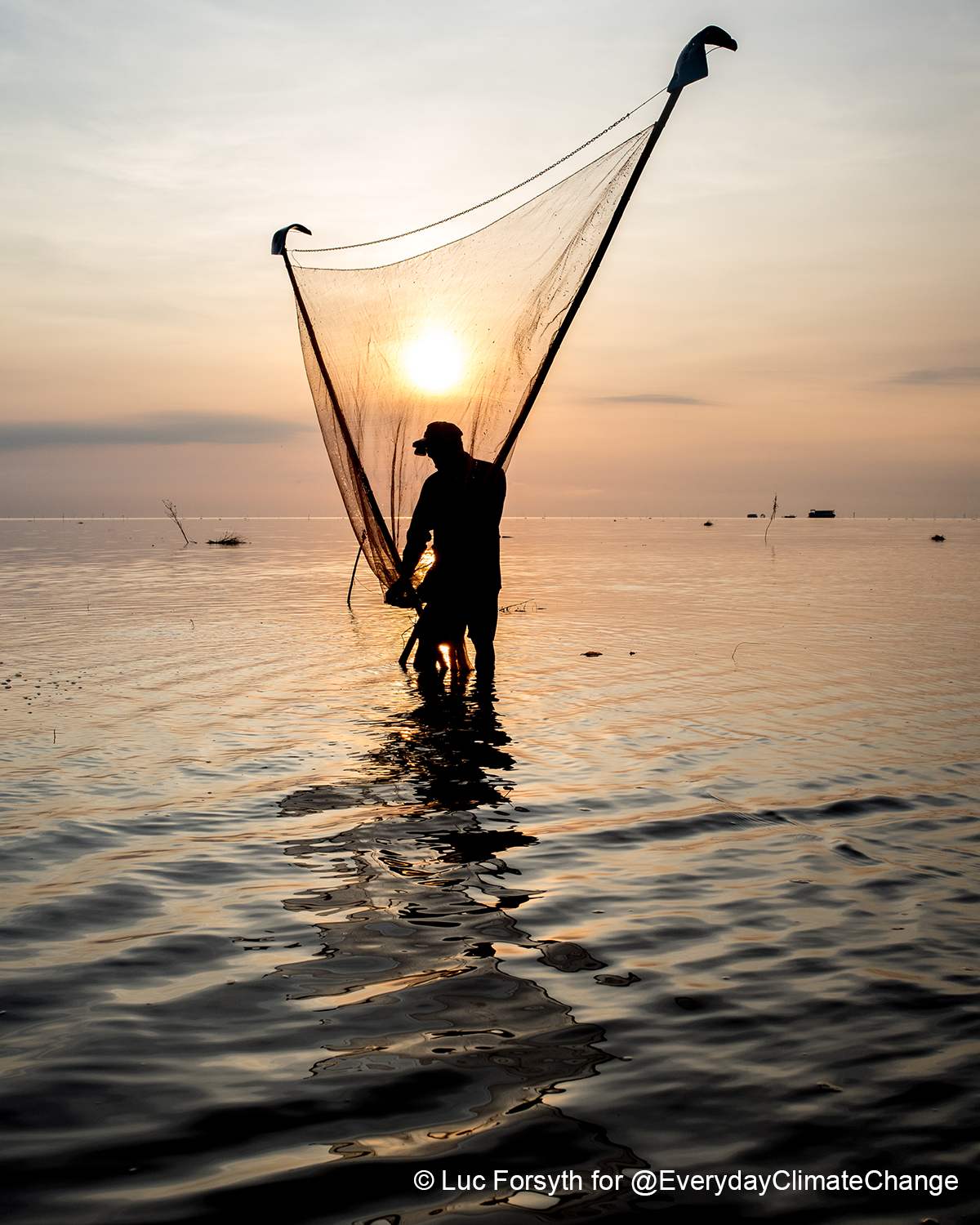
© Luc Forsyth (@lucforsyth for @EverydayClimateChange)
Over the past few centuries, the world has no doubt changed and progressed immensely. In spite of this, one thing remains constant - the ocean has been a source of food for tens of thousands of years and continues to play a vital role in the survival of our climate, marine life and humanity.
As we acknowledge the important role the ocean plays in our food supply today, it’s also time for us to recognise the challenges ahead. Did you know that by 2050, the world’s population will reach 9 billion and the demand for food will double? :o In addition, today’s food production, distribution, management and waste threaten wildlife, habitats and the planet itself :( Given this scenario, the need to improve efficiency and productivity while reducing waste and changing our consumption patterns as well as adopting sustainable practices has never been more important for the future of our planet and generations to come.
To combat the challenges ahead and secure a future where our planet will continue to be able to sustain us, WWF is working to improve how the world grows, transports and consumes precious resources through refining production and distribution systems, tackling environmental impacts and more. Plus, click here to find out more about how climate change affects food security.
12 Sep 2016: Local villagers fish in Tanandava, Madagascar

© Ed Kashi (@edkashi for @EverydayClimateChange)
From the vast blue sea to our wildlife and each and every one of us, we all share a collective home and it’s our responsibility to safeguard the future of this planet for generations to come. Photographed in Tanandava, Madagascar, this image offers a clear representation of the importance of our oceans. In addition to producing more than half the oxygen we breathe and providing a vital source of livelihood for millions of people, an estimated 3 billion people worldwide also depend on fish for at least 15 per cent of their protein intake!
However, the ocean is reeling under a multitude of threats such as unsustainable fishing, pollution, habitat destruction and more, bringing to attention the need for sustainable practices. In fact, the global fishing fleet of today is 2-3 times larger than the ocean can sustainably support, worsened by the fact that subsidies that encourage overfishing (mostly in developed countries) are worth an estimated US$14-35 billion :o
While the above might paint a bleak picture, the solutions to transforming the fishing industry exists - giving us the chance to save our seas and hence, protect our climate. From empowering communities to take charge of ocean resources in a way that safeguards their supply to encouraging better policies and driving better management, WWF is working across markets to drive sustainable practices. In fact, individuals like you can play a big part too by buying certified sustainable seafood! ;)
5 September 2016:A reminder why we should all care about the Arctic :)
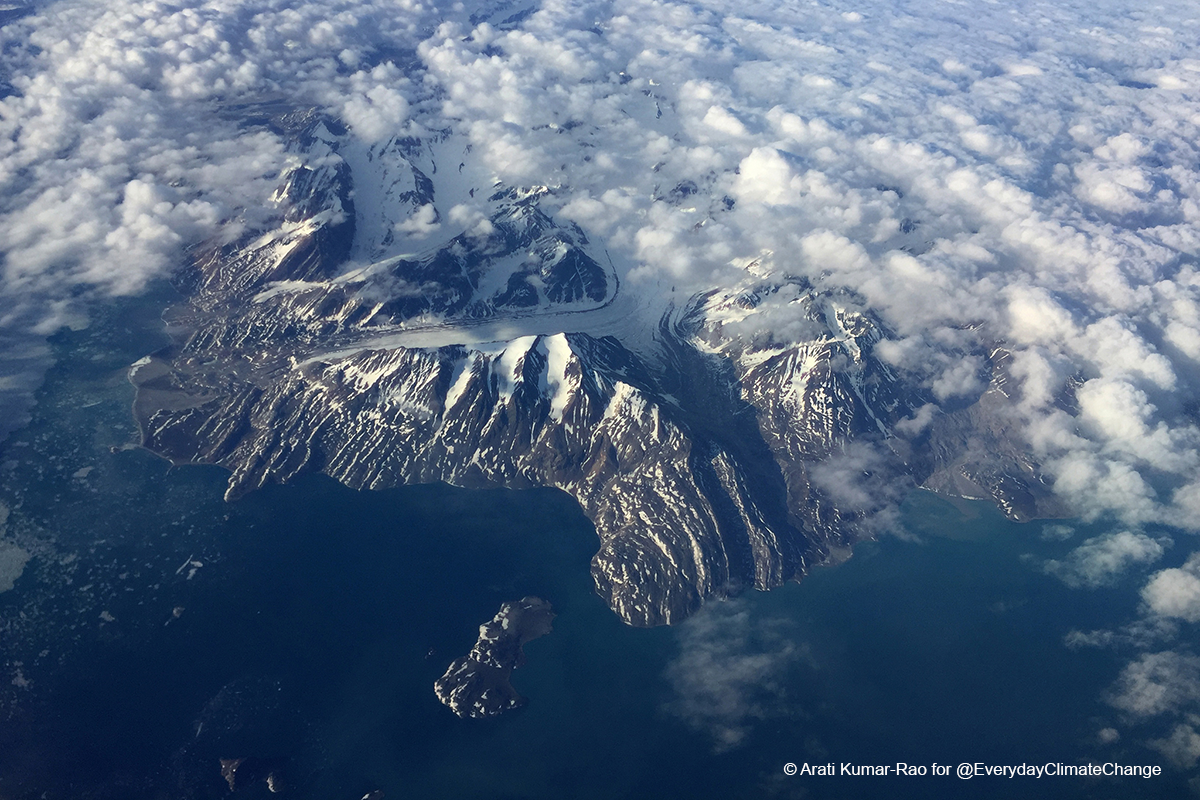
© Arati Kumar-Rao (@aratikumarrao) for @EverydayClimateChange
Located at the northernmost part of Earth, the Arctic is often thought of as a mythical and distant place to the rest of the world - and with a stunning view like that, it definitely gives the impression of a magical land far, far away. However, there are a multitude of reasons why we should care about the Arctic. Whether you’re located in Australia or Thailand, warming in the Arctic could affect us all to a great extent.
As the impacts of climate change continue to accelerate throughout the planet, the Arctic is expected warm at a rate two or three times greater than the rest of the world :o Even a slight shift in temperature could potentially lead to an ice-free Arctic within this century, putting Arctic communities, wildlife and the entire planet at risk (did you know that the Arctic is home to 4 million people and serves as a rich habitat for wildlife?) In fact, scientist Peter Wadhams recently said, “next year or the year after that, I think it will be free of ice in summer”, triggering even more rapid global warming.
With the Arctic already warming faster than the rest of the world, which in turn threatens the future of Earth, the need for climate action has never been more urgent. Find out how WWF is working to conserve this important ecosystem and find out how you can get more involved by getting in touch with your local WWF office!
29 August 2016:Tenzin Ngudup, 62, a Tibetan nomad who has lived near the source of the Mekong River his entire life.
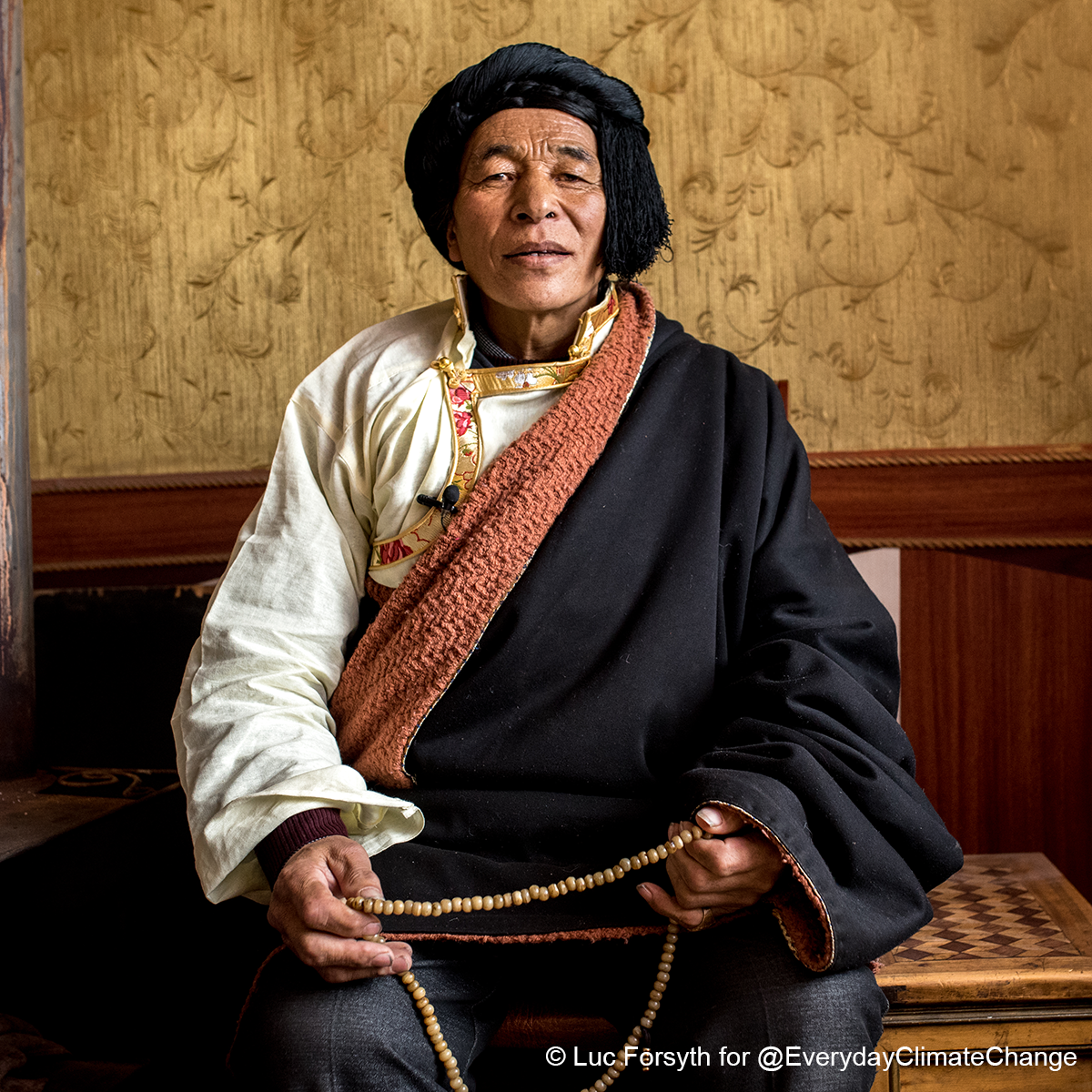
© Luc Forsyth (@lucforsyth) for @EverydayClimateChange
Beginning its 4,500km journey from the steep mountain gorges in China before flowing across the ‘Golden Triangle’ formed by the borders of Myanmar, followed by Lao PDR, Thailand, Cambodia and Vietnam, it’s no wonder the Mekong River takes the title of the world’s 10th largest river with a biological diversity close to that of the Amazon!
Having lived near the source of the amazing Mekong River his entire life, Tenzin Ngudup (photographed above), is definitely no stranger to the vital role water plays in each and every one of our lives. Without any hesitation, he says, “If I have to sacrifice my life to keep the water clean for the people and animals living downstream, I will be happy to do so.” Luckily, Tenzin Ngudup is not alone in the love and respect he shares for the river.
Along its massive course, the Mekong River serves as a lifeline for approximately 60 million people that depend it on it for fish and other resources in the river system for most of the protein in their diets. In fact, the river accounts for up to 25 percent of the global freshwater catch, in addition to acting as a source of water for cooking, cleaning, sanitation and irrigation.
However, the Greater Mekong is also one of the most vulnerable places on earth to the impacts of climate change and poses a serious risk to the region’s people, its biodiversity and natural resources. One notable challenge is water scarcity, which in turn leads to reduced agricultural productivity, resulting in food scarcity, unemployment and poverty :o
As one of the most precious resources known to man, water needs to be protected and the notion that we have a limitless supply of it is simply untrue. Whether it’s through building a climate-friendly future, making better policy decisions or raising greater awareness through events like World Water Week, we believe that together, we can build a better tomorrow for future generations :)
15 August 2016: As the tide rises, the village of Fuveme, located in Ghana, quickly gets flooded.
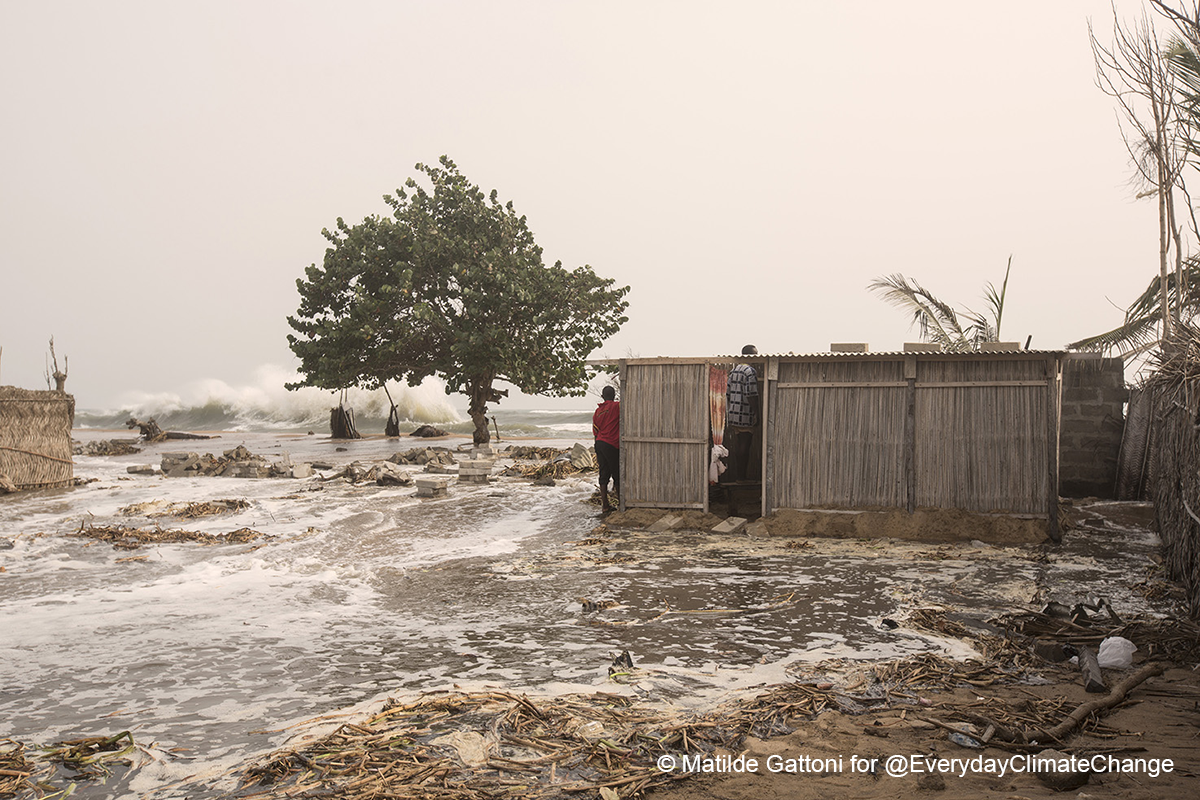
© Matilde Gattoni (@matildegattoni) for @EverydayClimateChange
As the impacts of climate change sweep across the world, many communities, wildlife and habitats are experiencing immense challenges as they find ways to adapt and cope with the effects of a rapidly changing climate. Photographed in the village of Fuveme, Ghana, the image above is testament to the very fact that many people in certain parts of the world are already right in the midst of climate change and experiencing its impacts on the environment and their livelihoods. As rainfall patterns have shifted in recent years, Ghanaians have seen firsthand what this means for their communities, highlighted further in Augustine Yelfaanibe’s Climate Witness testimony.
Over the years, Mr Yelfaanibe has witnessed a shift in rainfall patterns, which has serious implications for crop production for smallholder farmers and their households. For instance, scanty rains caused an initial drought in 2007 and by the time most crops had almost withered away, the rains returned very heavily resulting in serious floods in most parts of northern Ghana. In addition, climate change in the region has led to the many streams drying up, which in turn affects water supply. Read the full testimony here and find out more about ongoing conservation work in Ghana as we strive to build a climate-friendly future together :)
5 August 2016: In Riau, Indonesia, rainforests are being cleared to make way for plantations.
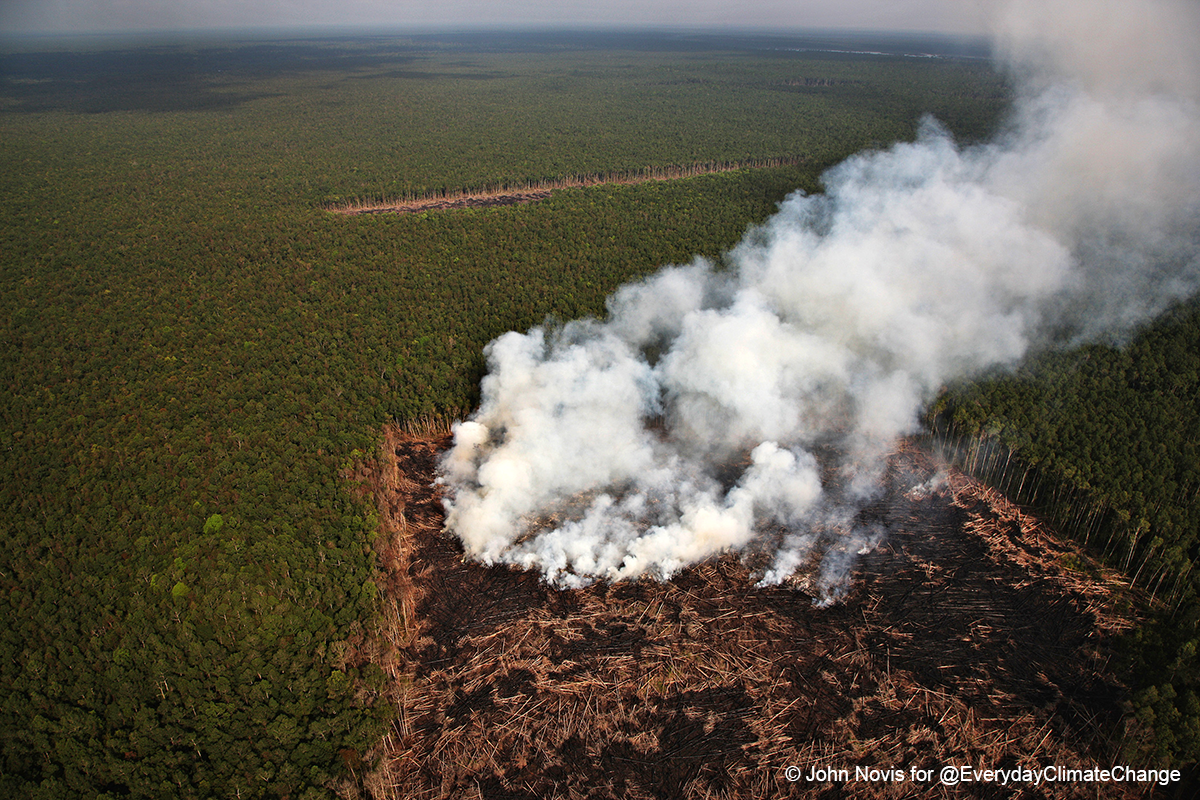
© John Novis for @EverydayClimateChange
Between 2000 - 2010, an estimated 13 million hectares of forests were lost per year :o and in tropical rainforests alone, deforestation continues to be an urgent environmental issue that threatens livelihoods, species and intensifies global warming. While the photograph above shows a dismal situation on the plight of our world’s forests, there is still hope to save the ‘lungs of the earth’ and help drive the movement to #ChangeClimateChange :)
In fact, the UN-REDD programme (Reducing Emissions from Deforestation and Forest Degradation), along with the nationally led initiatives that the programme supports, shows us exactly how we are working towards that goal. Adopted by WWF as well, the programme works on the guiding principles of climate, biodiversity, livelihoods, rights and fair and effective funding, and serves as an international policy mechanism whereby benefits flow from industrialized countries to forest-rich countries in exchange for avoided deforestation and forest degradation. With the aim of making tropical forests more valuable standing than felled, this in turn increases the security and sustainability of local livelihoods, protects forest biodiversity and decreases greenhouse gas emissions from tropical deforestation and degradation. And that’s not all - WWF also works across a multitude of projects with the goal of better protecting the world’s forests to help keep climate change at bay. Learn more about these amazing initiatives here and we hope you stay inspired to #ChangeClimateChange with us!
25 July 2016: A small village in the middle of the forest has a weekly coal market in Fenoarivo, Madagascar.
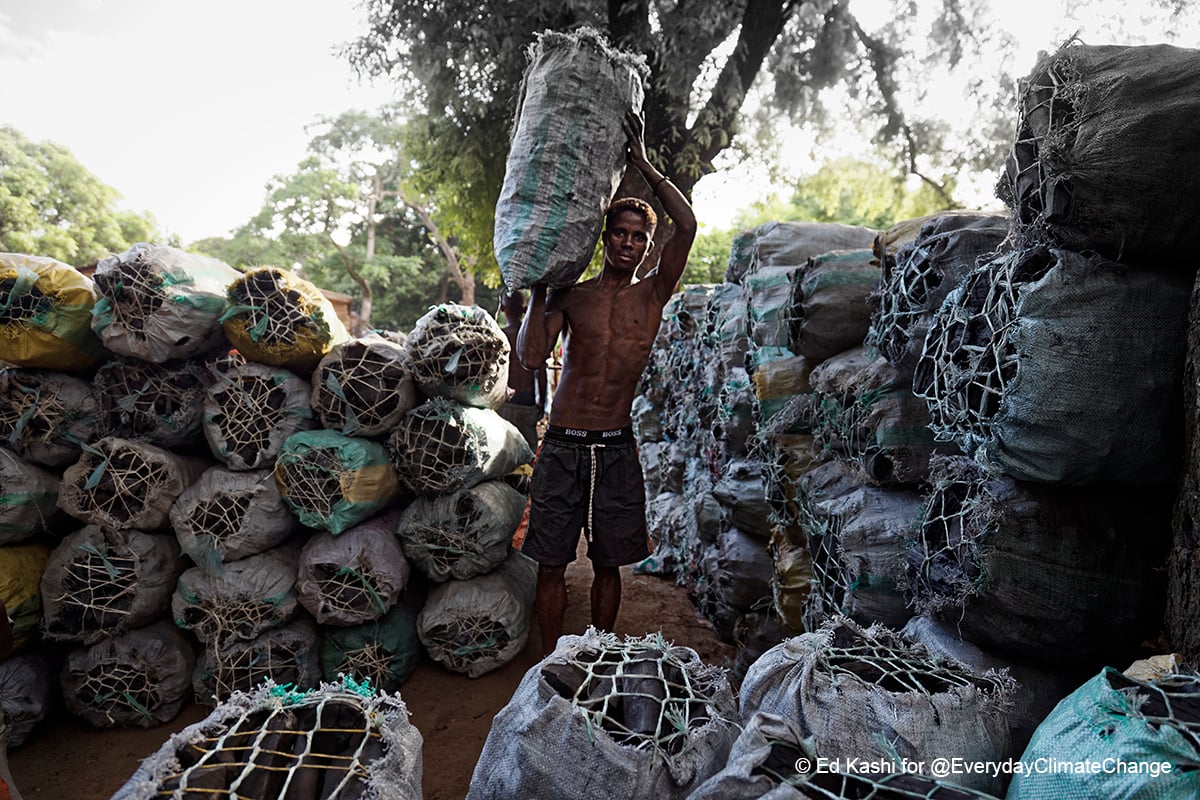
© Ed Kashi (@EdKashi) for @EverydayClimateChange
Formed from prehistoric vegetation that accumulated about 300 million years ago, coal is the most abundant and least expensive of fossil fuels. However, burning coal and other fossil fuels is also the largest single contributor to climate change, and with each passing day, the burden of coal continues to weigh down on the shoulders of our environment and the health of generations to come.
Associated with a multitude of detrimental effects, coal mining and use requires the removal of massive amounts of topsoil, leading to erosion, loss of habitat and pollution. In addition, coal mine workers also face serious health problems, including lung disease from prolonged exposure to coal dust in mines. But that’s not all - the impact coal has on the environment ranges from smog, to ground level ozone and acid rain, with coal and fuel oil combustion emitting fly ash particles into the atmosphere, and contributing to air pollution problems.
But there is a silver lining behind this ‘dark cloud’. The future of renewable energy is shining brighter by the day, showing us we have the technology, innovation and tools we need to #changeclimatechange! For starters, check out which countries are paving the way towards a future powered by clean energy and find out how you can help as an individual!
11 July 2016: A view of the shrinking Lowell Glacier in Canada's Kluane National Park.

© Peter Mather (@matherpeter) for @EverydayClimateChange
Beautiful, isn’t it? Shot in Canada's Kluane National Park, this view shows us exactly why we need to preserve the beauty of our national treasures for generations to come. From the North and South Poles, to these stunning National Parks, glaciers across the world are shrinking every day as a result of global warming, making the need for urgent climate action more pressing as the clock ticks.
In addition, with climate change leading to more extreme weather events, National Parks face even more threats as tropical storms and heavier rainfall threaten coral reefs, coastal ecosystems and communities. Whether it’s protecting these magnificent National Parks, or World Heritage sites such as Belize, Doñana, Selous and more, you can show your support for these amazing national treasures by making your mark to change climate change here! Together, we can safeguard our reefs, wildlife, habitats and more and create a future where people live in harmony with nature :)
4 July 2016: In a drought affected village along the Silk Road, a man uses a solar device to boil his kettle.

© John Novis (@Johnnovis) for @EverydayClimateChange
While droughts persist along the Silk Road in Northwestern China, a man still manages a smile as he uses a solar device to boil his kettle, reminiscent of the fact that renewable energy is vital to unlocking a better future for the planet, its people and wildlife.
As we load more heat into the atmosphere and oceans, the impacts of climate change continue to accelerate, with the poorest most exposed. From dangerous floods and storms, to droughts such as the one plaguing Northwestern China, extreme weather events are growing in frequency and intensity, which undermines human health and security as well.
To tackle the increasing risks of climate change, governments have acknowledged that we need to work together to keep global warming below 1.5 ˚C and avoid catastrophic climate change. From promoting low-carbon societies and cutting their dependence on dirty energy and fuels, to achieving our goal of sourcing 100 per cent of our energy from renewable sources by 2050 and working alongside businesses, WWF is striving to shift the world to a low-carbon economy and create a future where people and nature live in harmony :) Find out more here.
27 June 2016: A woman looks across the Taklamakan Desert in far-western China, one of the world's largest shifting-sand deserts.

© Bernardo De Niz (@bernardodeniz) for @EverydayClimateChange
Silky-soft sand fills the entire landscape of the Taklamakan Desert, China’s largest, driest and warmest desert, and though it offers a serene view, the loss of valuable land to desertification has been a growing concern.
In the last 150 years, half of the planet’s topsoil has been lost, with the quality of soil being affected by a multitude of factors, such as deforestation. Without plant cover, erosion can occur and sweep the land into rivers, leading to the loss of fertile soil, which makes land less productive for agriculture, creates new deserts, pollutes waterways and alters the flow of water, potentially resulting in more floods. Furthermore, soil erosion and degraded land are also often less able to hold onto water, adding to the risk of floods, as well as pollution and sedimentation in streams and rivers which causes a decline in fish and other species.
Being the anchor of all life on Earth and comprising a myriad of species that create a dynamic and complex ecosystem, it is imperative that we help to conserve one of the most precious resources on our planet. While there are many challenges to maintaining healthy soil which also supports farmers and the global community who depend on agriculture for livelihoods, there are also solutions such as promoting sustainable land use and reducing deforestation. Check out how WWF is working to protect our planet’s natural resources and find out how you can help too :)
20 June 2016: In Palawan, Philippines, soaring temperatures fuel concerns over coral bleaching.
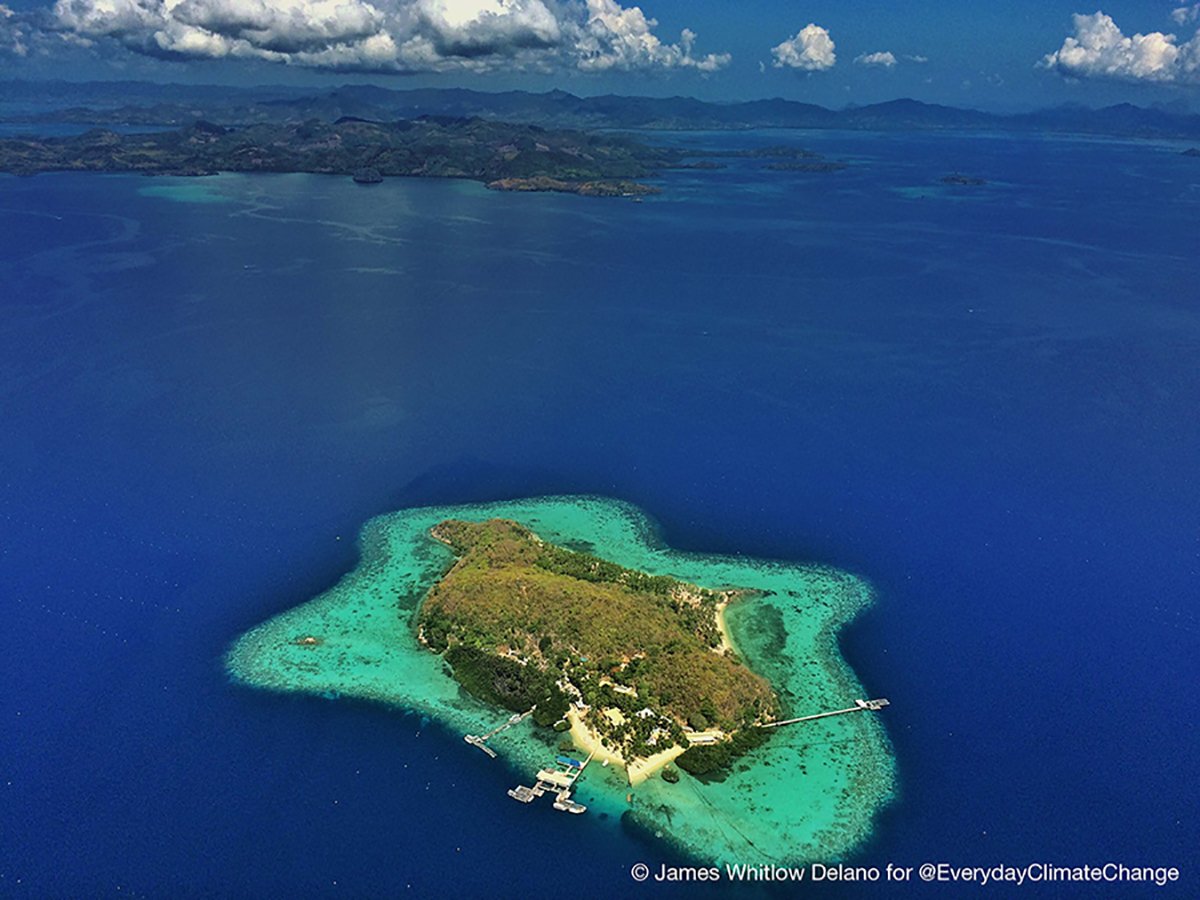
© James Whitlow Delano (@jameswhitlowdelano) for @EverydayClimateChange
The deep blue waters of Shark Fin Bay, Palawan might look like a respite from soaring temperatures, but under water, coral reefs are reeling under the pressure of a rapidly warming planet. Like an oasis in a desert, coral reefs provide food and shelter for a staggering amount of marine life, which in turn support the livelihoods of approximately 500 million people :o In addition, scientists estimate that there are at least one million species of animals, plants and other organisms on coral reefs - many of which are unknown to science! However, with the third global coral bleaching event becoming the longest one ever recorded, the need for urgent climate action has never been more visually apparent. We have to take climate action today and here’s why.
Absorbing up of 93 per cent of climate change heat, oceans have been rapidly warming which in turn affects the ability of corals to cope with today’s prolonged peaks in temperatures causing them to shed their colourful zooxanthellae (algae). Coupled with the current intense El Niño and the effects of unsustainable fishing and pollution, coral reefs are therefore turning white while some die, threatening the future of these amazing ecosystems.
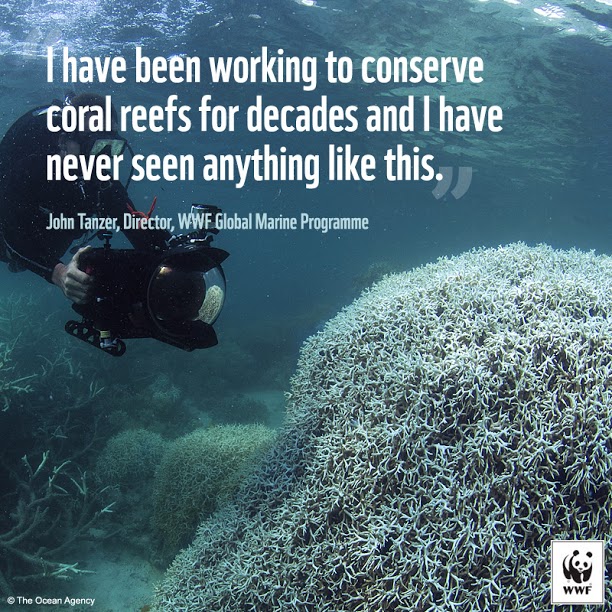
Announced in October 2015 and expected to last until the end of 2016, the third global coral bleaching event has already become the longest one ever recorded. In spite of this, we can still do our part to protect the future of these ecosystems and hopefully restore their vibrancy in time to come. Help usspread the word on climate change and reef conservation today and learn more about the Great Barrier Reef here.
6 June 2016: Along the Brahmaputra riverbed, collecting stones provides a source of income for communities.
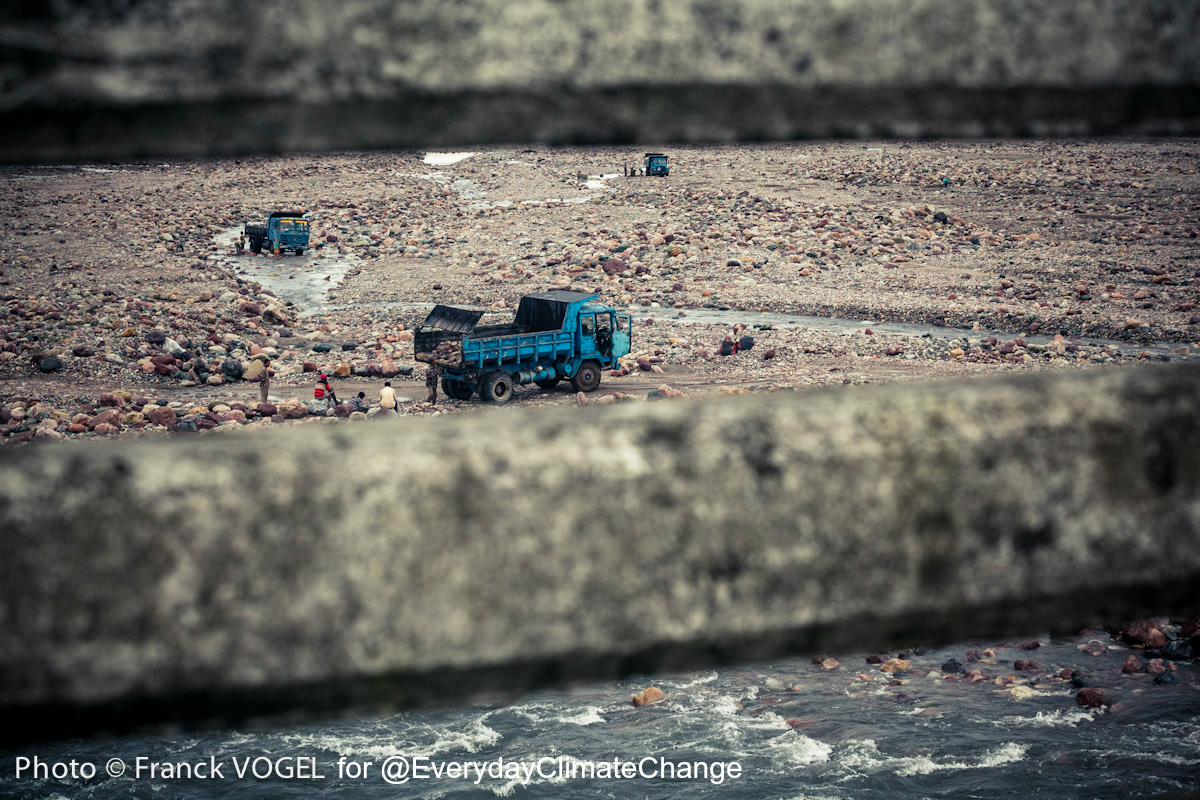
© Franck Vogel / @franckvogel for @EverydayClimateChange
Originating in southwestern Tibet as the Yarlung River, the Brahmaputra flows on to become one of Asia’s major rivers, breaking through the Himalayas in great gorges and finally merging with the Ganges to form a vast delta. At about 2,900 km long, the Brahmaputra accounts for nearly 30 per cent of total water resources in India and about 40 per cent of total hydropower potential of the entire country. In addition, the river is also home to the endangered Ganges River dolphin.
Despite the force of this river, climate change is a serious challenge, especially in the low-lying areas of the Ganges-Brahmaputra Delta. By 2050, the IPCC Fourth Assessment Report indicates that more than a million people will be put at risk as a result of decreased sediment delivery by rivers and rising sea levels. Furthermore, soil erosion as a result of deforestation in the valleys of Tibet and north-east India have led to frequent flooding of the delta region in Bangladesh on a massive scale in recent years, endangering the lives of many. To learn more about the world’s rivers that support the health and survival of billions of people and vast ecosystems, click here.
30 May 2016: An aerial view of London’s cityscape reminds us of the endless possibilities we can achieve when we come together.

© Jeremy Sutton-Hibbert / @JshPhotog for @EverydayClimateChange
From skyscrapers that defy gravity, to a complex and endless system of roads that brings you from one end of the city to the other, this view of the London city landscape shows us that together, anything is possible.
While cities generate more than 70 per cent of the world’s carbon emissions, they are also home to more than half of the world’s population, and each and every citizen - reaching a total of over 3.5 billion people - holds the key to changing climate change and unlocking a sustainable future where we live in harmony with the environment. From providing quality housing to clean energy, transport and more, the opportunity to come together and find smart solutions to improve lives and protect our collective future and home has never been more attainable, especially in a world where people are becoming more connected than ever.
To show your support for a greener, more sustainable future, visit www.welovecities.org and join the millions of people shaping the future of sustainable cities all over the world! Plus, remember to join us in the movement to change climate change :)
23 May 2016: The Prime Minister of Tuvalu signs the Paris Agreement in New York on April 2016, showing the country’s commitment toward helping make the deal a reality
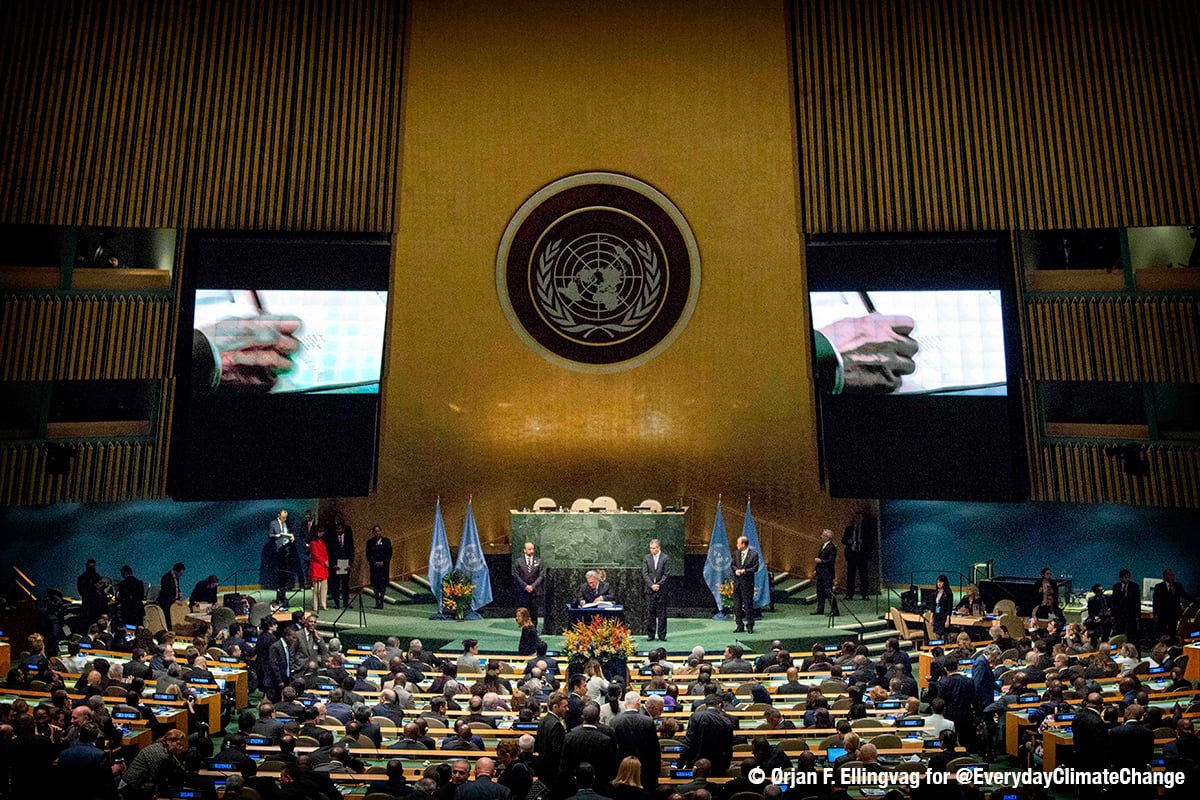
Ørjan F. Ellingvag for @EverydayClimateChange
For countries like Tuvalu which are on the very frontlines of climate change, turning the Paris Agreement into reality is a matter of survival. Located in the South Pacific, the remote island nation that is often associated with the accelerating impacts of climate change, could gradually disappear if sea levels continue to rise as predicted. In the face of such adversity, the country has displayed an admirable spirit in its commitment to climate action by signing and ratifying the world’s first universal climate deal agreed upon at the COP21 climate summit in Paris in December 2015. Back home, volunteers, government partnerships and civil society endeavour to address the issue of climate change through risk reduction and disaster preparedness to lessen the worst effects of global warming and other challenges facing the population.
As countries endeavour to turn the goals in the Paris Agreement into reality, we hope that the ambition, spirit and resilience of Tuvalu, along with other nations vulnerable to climate change such as the Marshall Islands will urge nations to go further in their efforts to change climate change. As of 29 April 2016, the Paris Agreement has seen 177 signatories, of which 16 states have also deposited their instruments of ratification, acceptance or approval accounting in total for 0.03 % of the total global greenhouse gas emissions.
While this marks a step in the right direction, much remains to be done to avoid the worst impacts of climate change, and we need to work together toward a climate-friendly future now more than ever. Find out how a 100% renewable energy future is the way forward and join us in the movement to change climate change!
16 May 2016: Bassirou Sambou in an estuary that runs through the mangroves in the Casamance region of southern Senegal.

© J.B. Russell for @EverydayClimateChange
This captivating image brings to mind how we’re all connected on this Earth from land to sea, to our forests and wildlife. Blessed with a planet that offers limitless beauty, it’s also up to us to protect the only home known to our species and ecosystems from the many threats it faces today, such as climate change. For example, mangrove forests, places with an unparalleled bounty of biodiversity riches, are critically endangered today. Faced with a variety of threats ranging from climate change, overfishing, pollution and more, these ecosystems are fast disappearing, with more than 35 per cent of the world’s mangroves already gone :o This figure is as high as 50 per cent in countries such as India, the Philippines and Vietnam, while in the Americas they are being cleared at a rate faster than tropical rainforests.
For many of us, the importance of these ecosystems might seem remote, but mangrove forests go a long way in helping the environment and hence, the communities and wildlife that depend on it for their survival. Home to a large variety of fish, crab, shrimp, and mollusk species, these ecosystems contribute to an essential source of food for thousands of coastal communities across the world, and are also extremely valuable to indigenous communities that require construction materials and fuel due to its resistance to rot and insects. And that’s not all, the dense root systems of mangroves also trap sediments flowing down rivers and off the land, which helps to stabilize the coastline and prevents erosion from waves and storms.
To alleviate the situation and help build a better future for our climate and environment, WWF is working with governments, communities and other stakeholders to protect and reduce the vulnerability of the world’s coastal ecosystems. Find out more here and remember, individuals like you can help make a difference too :)
9 May 2016: A schoolgirl watches the rising tide in Ghana
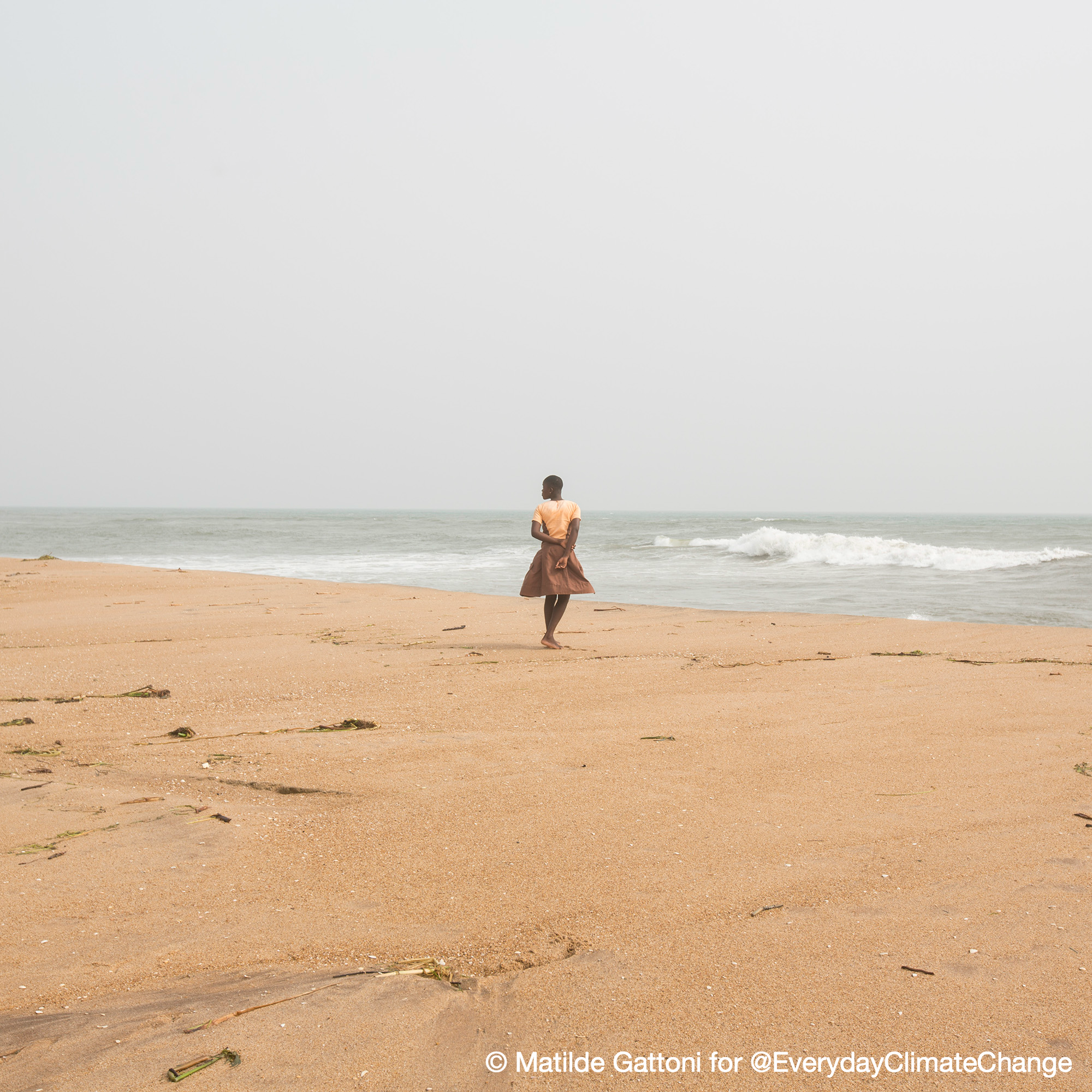
© Matilde Gattoni for @EverydayClimateChange
As we meet people of vastly different cultures across different countries in today’s highly globalized world, it’s interesting to think about how our roots and that of human civilization in general trace all the way back to one continent - Africa. Considered to be the birthplace of the human species, Africa is filled with layers upon layers of history. Unfortunately, today it is also one of the most vulnerable regions in the world to climate change, on the frontlines of the need to adapt to the challenges of a changing climate.
In the 20th century alone, temperatures over most of the African continent warmed by approximately 0.7°C. Over the next century, this warming trend, and changes in precipitation patterns, are expected to continue, being accompanied by a rise in sea level and increased frequency of extreme weather events. In addition, climate change is also expected to put other factors such as Africa’s biodiversity, agriculture, water supply and more at risk. In fact, the continent’s marine life is already feeling the effects - coral reefs in the Indian Ocean experienced massive bleaching in 1998, with over 50 per cent mortality in some regions, creating serious implications for fisheries, food security and marine biodiversity.
To combat this, WWF is working to address the current and projected effects of climate change in Africa through a multitude of projects such as advocating for policies that reduce emissions of heat-trapping gases, renewable energy, increasing energy efficiency and much more. To contribute towards building a climate-safe future, join the movement to #ChangeClimateChange today :)
2 May 2016: A glimpse into the lives of the stewards of the planet
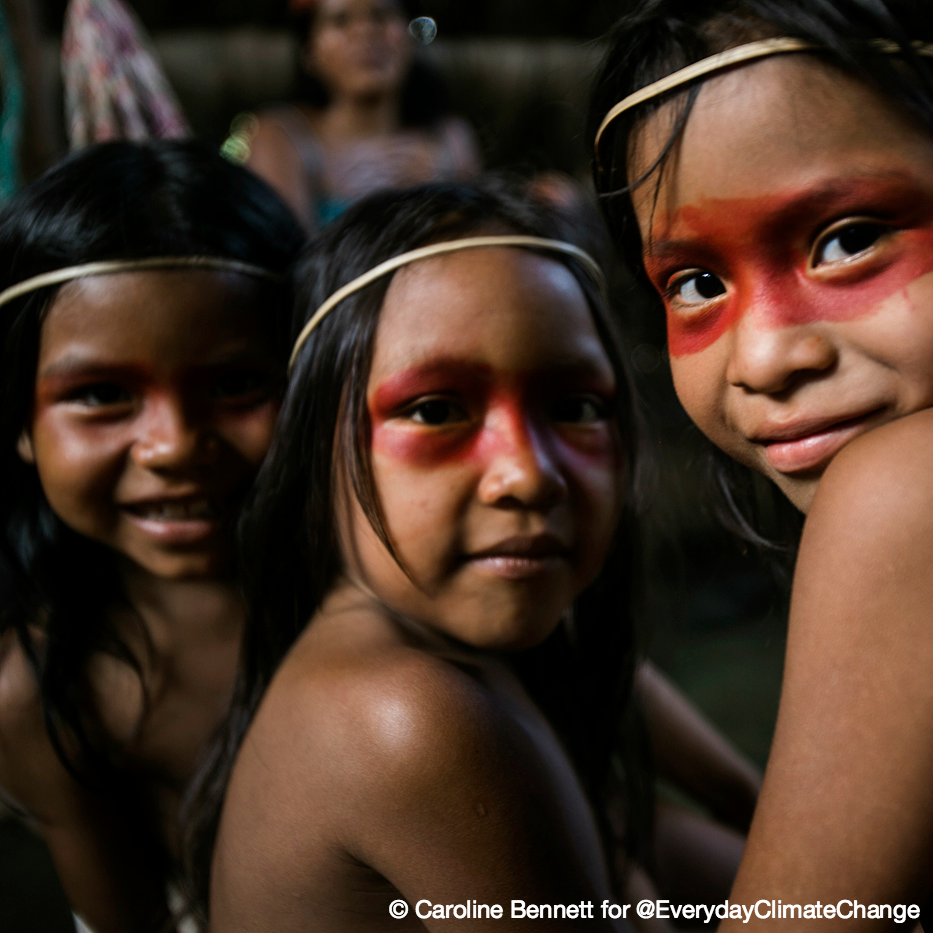
© Caroline Bennett (@carobennett) for @EverydayClimateChange
[Waorani children in the village of Bomeno, Ecuadorian Amazon. ]
Photographed in the village of Bomeno, in the Ecuadorian Amazon, this beautiful snapshot of Waorani children offers a glimpse into the lives of some of the world’s indigenous peoples and communities living in the majestic rainforest.
Unfortunately, widespread deforestation is pushing the Amazon and the homes of these communities to its limits, which is also a deep cause for concern given the fact that the world’s climate depends on the health of these forests. Apart from storing vast amounts of carbon, these huge forests regulate global rainfall patterns. Add on the impacts of climate change and this could translate to more disastrous effects, which will not only lead to a loss of biodiversity, but greatly impact the millions of people and communities who live in and depend on forests for their livelihoods.
We know that together, we can work towards a better future, and signing the Paris Agreement marked the first important step toward global efforts to change climate change :) Also, find out more about how WWF is collaborating with local communities and indigenous peoples, who have helped maintain some of the world’s most fragile ecosystems over years and centuries, to create a world where people live in harmony with nature.
25 April 2016: Often viewed as barren, we like to think the resilience of the desert is something to learn from.
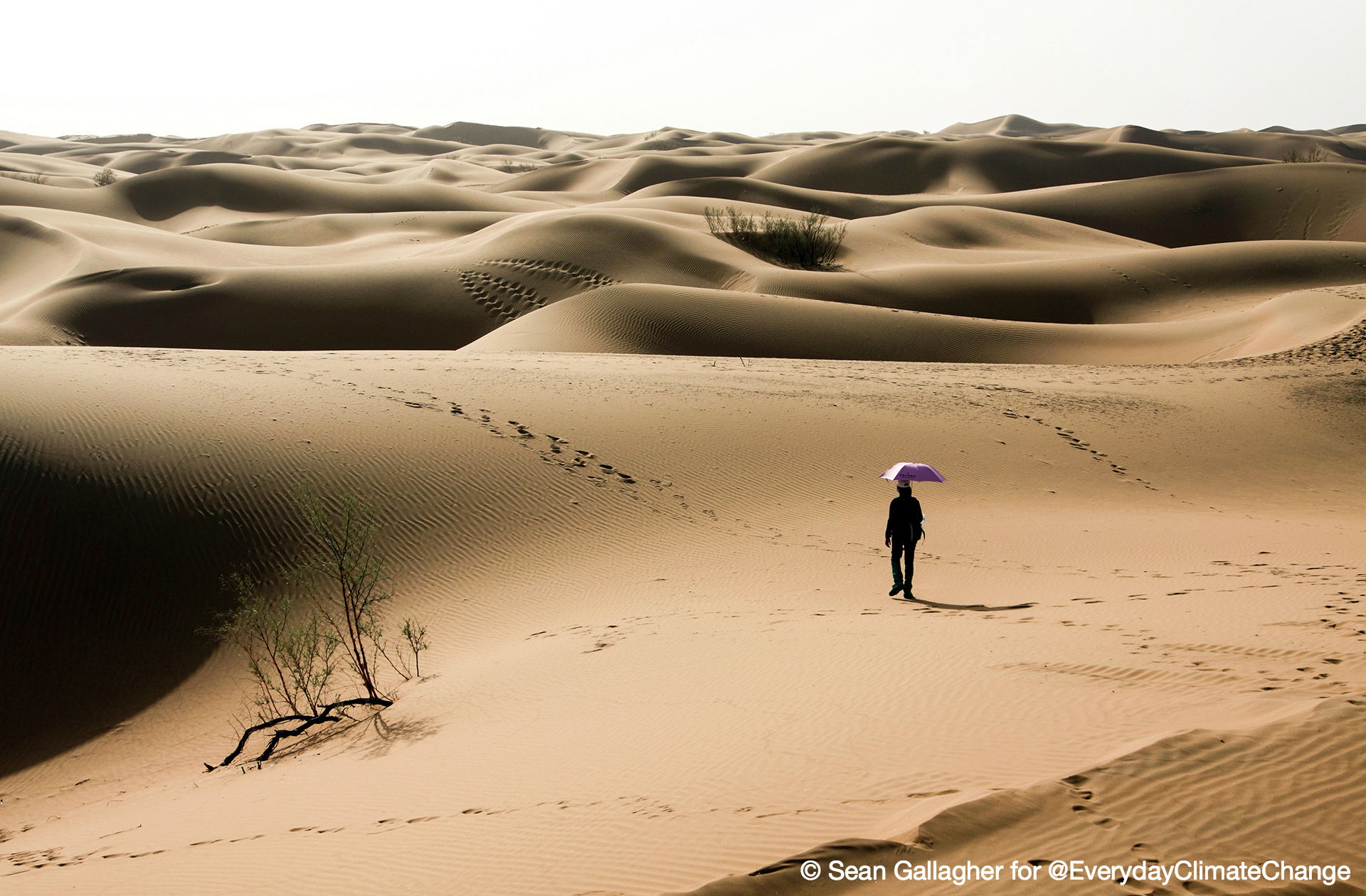
© Sean Gallagher (http://gallagher-photo.com) for @EverydayClimateChange
In the absence of flora and fauna, we often think of deserts as a vast plain of inhabitable and harsh land, and while landscapes of these habitats often conjure up uninviting and barren images, that notion isn’t entirely accurate. Though lacking in water, deserts don’t lack life - shrubs, plants, animals and other organisms have reached a stage in their evolution that allows them to minimize water loss and survive in a habitat with little water. In fact, animal diversity in the desert is considered high - especially among reptile species.
However, hot and dry as they may be at present, climate change and rising temperatures could make deserts an even more uncomfortable place to live in in the future. Drinking water for a staggering 500 million people who live in deserts is either disappearing or becoming too scarce as snowpacks and glaciers that feed desert rivers melt. Coupled with a growth in population and unsustainable groundwater extraction, a greater strain will be placed on the precious resource.
But while the severity of climate change as a threat to our planet, habitats and wildlife grows everyday, it’s not too late for us to act now. More than anything, the resilience of these habitats is indeed an attribute we can all learn from in the movement to change climate change. Together, let’s work towards a better future :)
18 April 2016: Water - the source of all life on Earth and our planet’s most precious resource.
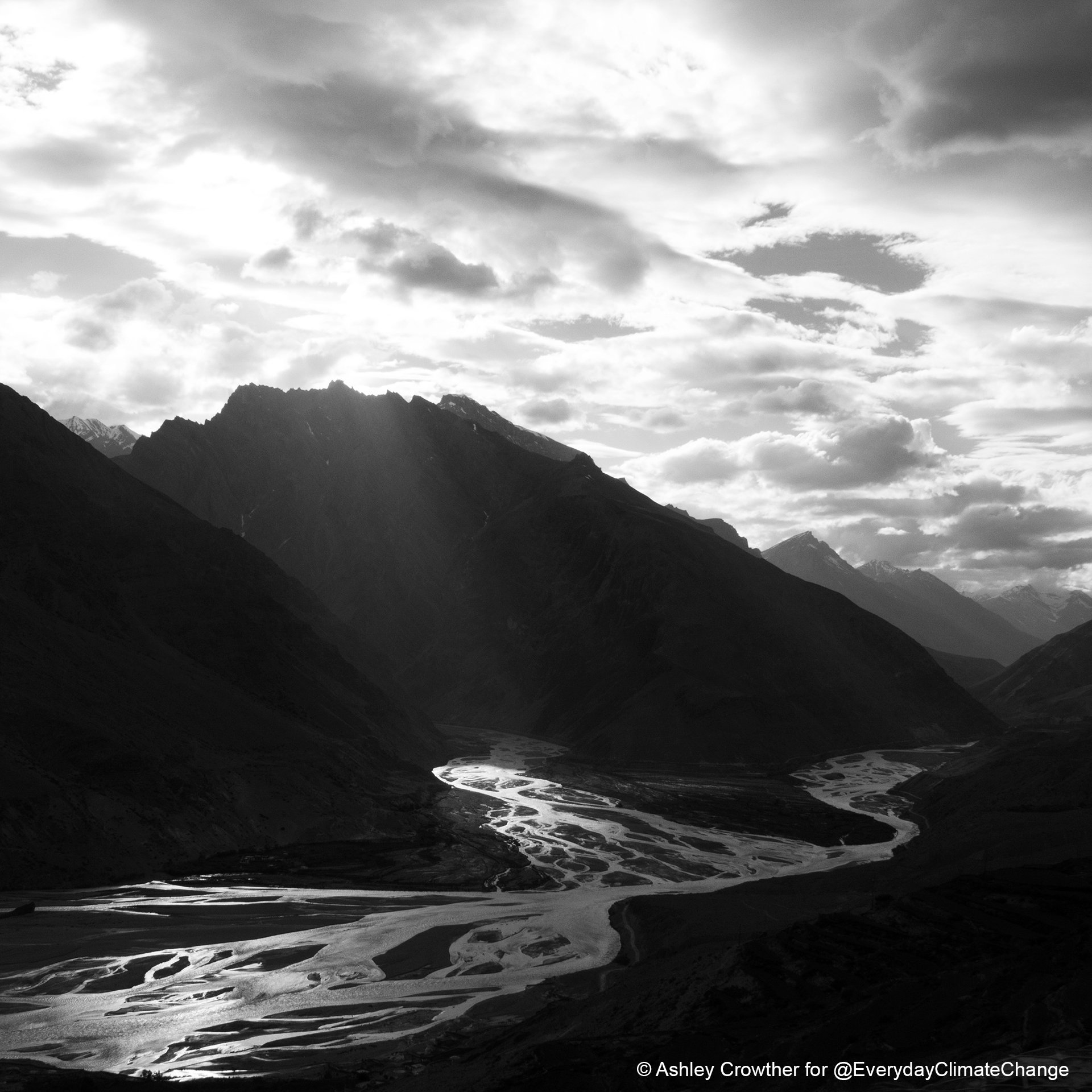
Ashley Crowther (@ashleycrowtherorg) for @EverydayClimateChange
As the sun shines on the river in this magnificent shot of the Himalayas, it evokes a reminiscent mood, taking us back to the source of all life on Earth- water. It is truly amazing to think about how water is the force behind almost everything we take for granted - from the food we eat to the clothes we wear and the energy we depend on everyday.
However, with the effects of global warming and climate change accelerating, our most valuable resource is also facing many threats. Global warming and extreme weather events are putting millions of people at risk of floods, droughts and shortages of drinking water, while population growth, unsustainable water use and changing consumption patterns are just a few of the myriad of forces putting increasing pressure on freshwater systems.
With water covering 70% of our planet, it is easy to think there is a limitless supply but did you know that only 3% of water on the planet is freshwater and overall a mere 1% is readily available for human use? In fact, if we don’t act now, almost half the world's population will be living under severe water scarcity by 2030 :o .
This is our time to get with the flow ;) Today, WWF is partnering with governments, businesses, communities, and industries to ensure a thriving future for our planet, its people and all its wildlife. Learn more on how you can help protect our planet’s most invaluable resource here.
11 April 2016: The ‘Forest Man of India’ shows us the power of individual actions

© Franck Vogel (@franckvogel for @everydayclimatechange)
To #ChangeClimateChange, we need everyone, and Jadav Payeng (pictured above), truly shows us the power of individual actions and how all our efforts big or small, can make a difference to our environment.
Also known as ‘Forest Man of India’, Jadev Payeng has been planting trees and seeds since the 1970s, creating an astonishing 1400 acres of forest! :o Taking into account the importance of our forests and the role they play in regulating our climate, it’s amazing to think about how one individual has accomplished such a feat :) In fact, it wasn’t too long ago, 2013 to be exact, when individuals in Uganda came together to build the world’s first Earth Hour Forest as well, in their efforts to #ChangeClimateChange and fight deforestation in the country.
While many countries and communities across the globe are already feeling the impacts of climate change, its not too late to do your part and these stories show us that every action counts. We hope this inspires you to act today ;) Start today by joining us in the movement to #ChangeClimateChange - together, we can build a better future for our planet, its people and all our wildlife.
4 April 2016: Our rivers know no boundaries, and neither should climate action :)

© Caroline Bennett (@carobennett) for @EverydayClimateChange
Beautiful, isn’t it? Shot in the Amazon, this image of one of the world’s many free-flowing rivers truly reminds us of the magnificence of the planet we all share. Known as the ‘arteries of our planet’, the steady flow of clean, freshwater, is an essential element for vast ecosystems and the health and survival of various types of species and billions of people.
However, issues such as physical alterations of river flow, deforestation, pollution, climate change and more, are threatening the health of our rivers. For example, pollution arising from poorly managed industrial processes could result in water that is unsafe to consume, combined with other more insidious effects that build up in the food chain for many years. In addition, long-term changes in rainfall, river flow and underground water supplies as a result of climate change could lead to increased flooding in certain rivers, while others become progressively drier. The combined effects of these threats will no doubt greatly impact our species, and the billions of people who are dependent on the world’s rivers for their survival. In fact, most projections show that the rate and scale of climate change-related impacts are only set to grow.
As the impact of climate change accelerates, the need for climate action becomes increasingly urgent. Wherever you are, join us and do your part to #ChangeClimateChange today - together, we can turn the tide on climate change and build a better future for our planet and generations to come :) - earthhour.org/join-the-movement
28 March 2016: Climate change is threatening the survival of our wetlands
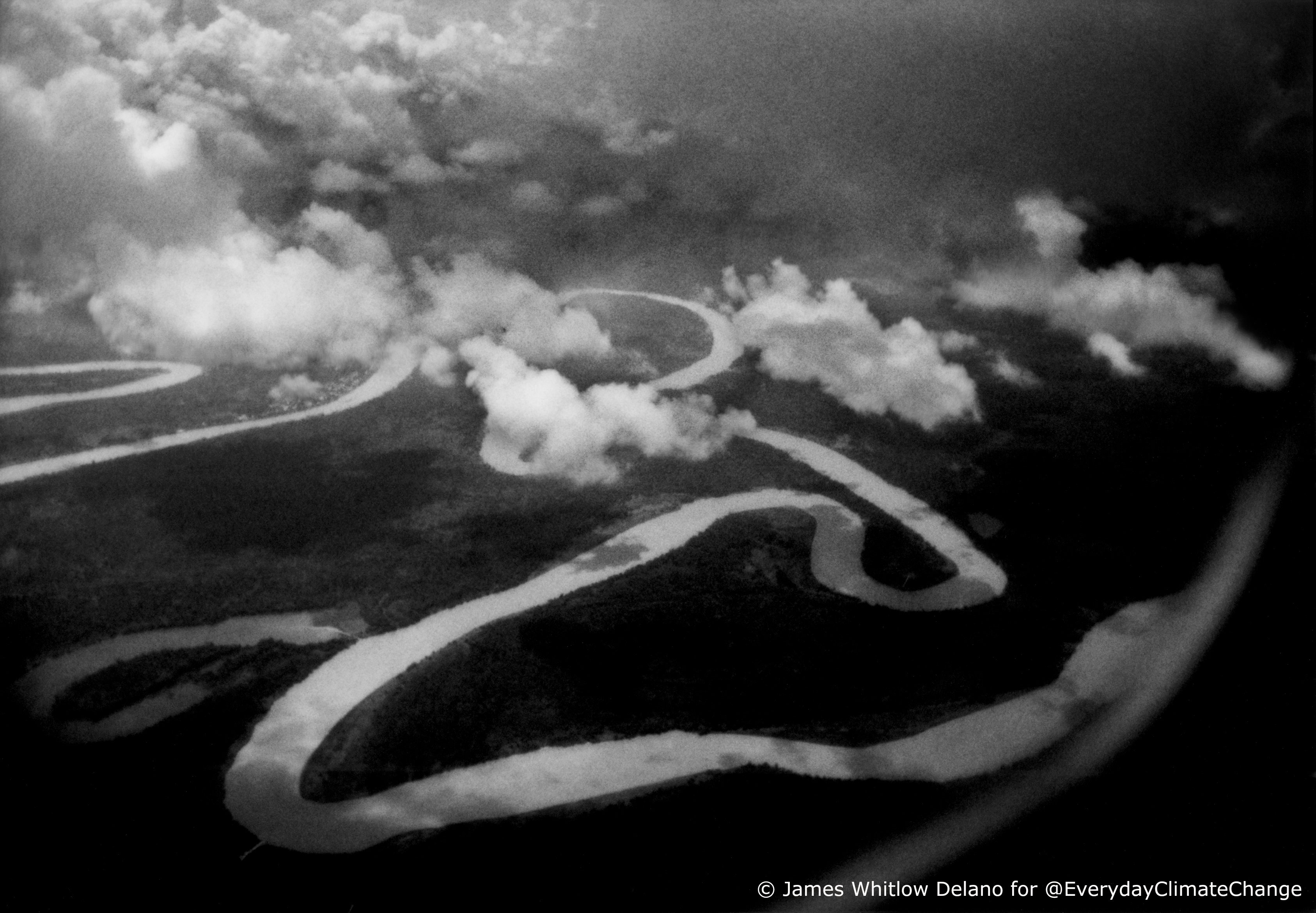
© James Whitlow Delano (@jameswhitlowdelano) for @EverydayClimateChange
Tucked away around the Baram River in Sarawak, Borneo island, these meandering and free-flowing stretches of wetlands remind us that the planet we live on is truly beautiful, and it’s worth going the extra mile and beyond to #ChangeClimateChange :)
Today, the survival of our wetlands continues to be threatened due to a variety of reasons ranging from industrial threats and pollution to climate change and more. With rising temperatures causing our polar ice to melt and increasing sea levels, shallow wetlands are becoming swamped, putting the biodiversity dependent on these wetlands, such as mangroves at risk. Furthermore, with climate change contributing to extreme weather events, our wetlands are also being impacted by droughts etc. In fact, the world has lost half of its wetlands to date since 1900 :o
Closing in on the heart of Borneo itself, activities such as illegal logging, unsustainable palm oil practices , deforestation and climate change are also threatening the island. If current rates of deforestation in Borneo persists, WWF projects that the island will be severely affected by climate change through the increased risk of floods and forest fires, human health impacts, changes in agricultural yields and damage to infrastructure. In spite of this, we can still act today to preserve the magnificence of our planet and create a better tomorrow for future generations. Get started by joining the movement to #ChangeClimateChange today and remember, climate action begins with each and every one of us.
15 February 2016: A massive iceberg floats in the Southern Ocean, off Antarctica.

© Jeremy Sutton-Hibbert @JshPhotog for @everydayclimatechange
Antarctica might be the highest, driest, windiest and coldest continent, but everything has its limits. In spite of its tough exterior, even Antarctica is reeling under the impacts of climate change.
While the coldest continent on Earth might seem like a far and distant place to many of us, both our Polar Regions play a critical role in regulating our planet’s climate and their importance to us can never be over-emphasized.
In addition, Antarctica is home to a large number of the world’s marine mammals and other important marine life, with its nutrient-rich waters and constant summer sunlight encouraging the blooming of phytoplankton, the foundation of the ocean’s food chain.
Whether we feel it directly or not, climate change is happening right now and our planet needs your help to #ChangeClimateChange. This Earth Hour, join us to shine a light on climate action - for our future generations, wildlife and of course, our adorable penguins! :)
8 February 2016: The beauty of the Himalayas is yet another reason why we need climate action now

© James Whitlow Delano (@jameswhitlowdelano) for @EverydayClimateChange
Photographed in Tibet, this breathtaking view of the Himalayas definitely evokes a sense of wonder, and reminds us of just how beautiful our planet is. Spanning across countries like India, Nepal, Tibet and more, the Himalayas are home to an amazing diversity of life, including 163 globally threatened species. In addition, they also serve as a vital source of freshwater for millions of people, its resources helping sustain lives and livelihoods through the year.
However, majestic as they may be, the Himalayas are still vulnerable to the impacts of climate change, melting at a rate faster than ever before and threatening wildlife and the lives of millions of people that depend on it. To add on, the changing pattern of rainfall is another cause for concern, as it creates more challenges for locals in the form of food security. Yet another factor that exacerbates the current situation is the growing need for food, shelter and industries, which is exerting tremendous pressure on nature.
To conserve the beauty of the Himalayas and help safeguard the millions of species and people dependent on it, WWF has been working across the region to protect its forests, landscapes, ecosystems and more. You too can help and be the voice that our planet needs. Join us to shine a light on climate action this Earth Hour; together, we can change climate change :)
1 February 2016: The secret to happiness.
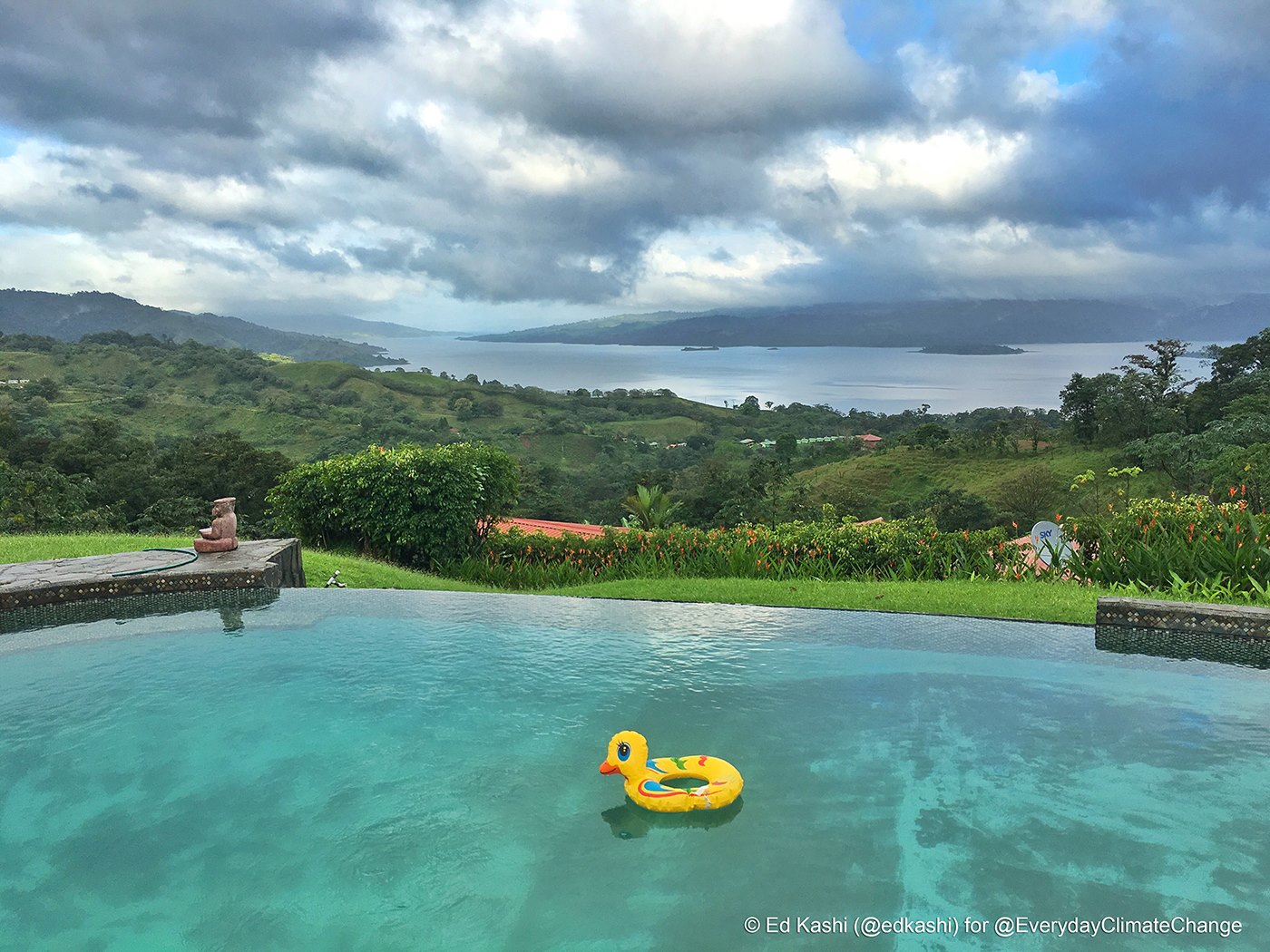
© Ed Kashi (@edkashi) for @EverydayClimateChange
With a view like that, it is perhaps no surprise to find Costa Rica does so well on the Happy Planet Index :). Add to that, the wonderful news that the country is also close to becoming the first 100% renewable energy-powered country in Latin America and we can’t help but feel quite happy and excited ourselves!
In addition, despite the fact that the world has lost half of its original forest cover in the past 50 years alone, this Latin American country has managed to go against the trend, succeeding in increasing it’s forest cover from 24% of the total land in 1985 to almost 52% in 2012! Given the vital role that our forests play in mitigating climate change, that’s definitely an achievement to be proud of.
Safe to say, Costa Rica is setting a fantastic example for the kind of climate action our planet needs, and perhaps that’s the secret to happiness :) On that note, do your part to change climate change and inspire others to do the same – join us for Earth Hour today!
25 January 2016: Despite the view of Egypt’s thundery clouds, the problem of water scarcity looms over the country.
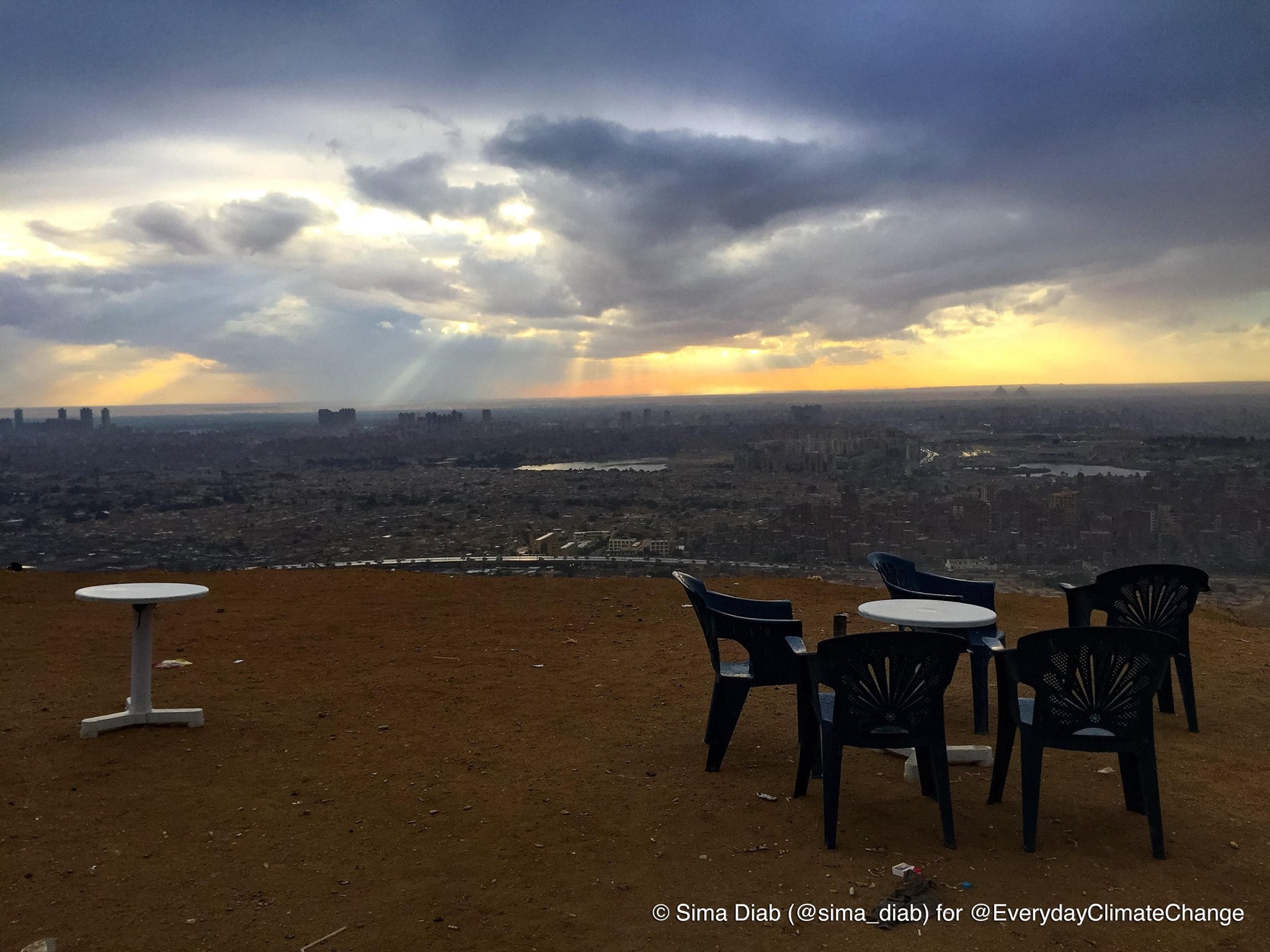
© Sima Diab for @EverydayClimateChange
Heavy clouds engulf the skies of Egypt on a Saturday afternoon, forming a magical view befitting the country home to the Nile River. However, the truth is that although the country is often called the ‘gift of the Nile’, the country could face a serious water crisis in coming years due to growing water scarcity. In fact, the UN says the country will face ‘absolute water scarcity by 2025’.
Living on a planet that’s 70% covered by water often brings up the misconception that the precious resource will always be available in abundance. But freshwater, which is needed for many things - from the beverages we consume to irrigating our farm fields- is incredibly rare. To be precise, only 3% of the world’s water is considered to be fresh water; and out of that 3%, two-thirds is tucked away in frozen glaciers or otherwise unavailable for our use :o
That’s not all. As we continue to pump more greenhouse gases into our atmosphere and climate change continues to accelerate, weather patterns and water will change across the world, leading to more floods and droughts. The combined effects of these changes means that water supply for agriculture, ecosystems, cities and other necessities across the world could be severely threatened.
Yet, just as the image depicts, there IS a silver lining. Join us and with your help, we can shine a light on climate action today to build a better tomorrow - it all begins here. To find out how you can help, and what WWF is doing to help to manage water scarcity, click here.
18 January 2016: Heavy clouds of smoke shroud a forest in Liberia due to slash-and-burn practices.
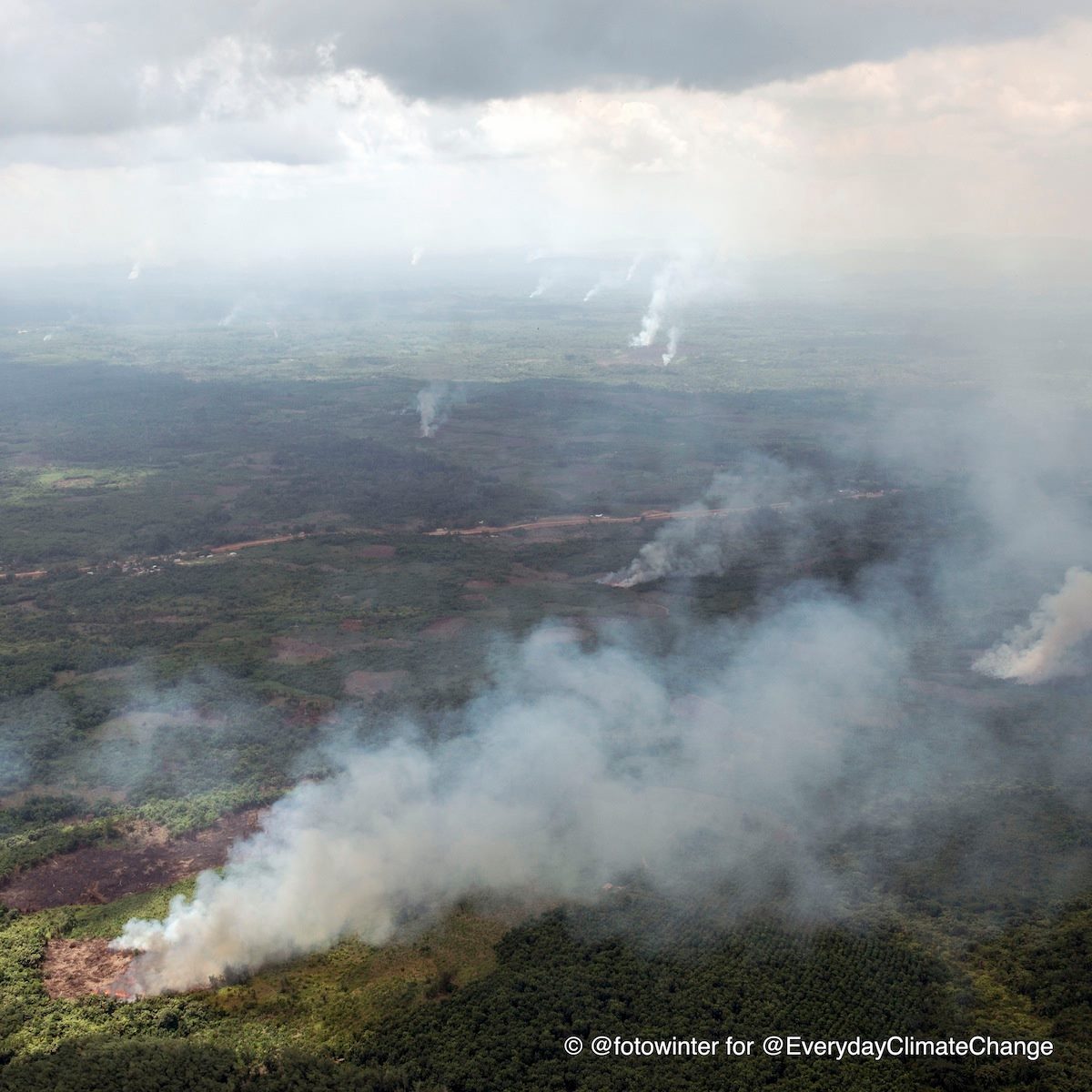
© Staton Winter (@fotowinter) for @EverydayClimateChange
The list of reasons on why our forests are so vital to our planet’s survival is perhaps endless, yet they are being lost at an alarming rate due to slash-and-burn practices (pictured above), illegal logging and more. In fact, in the past 50 years alone, we have lost about half of the world’s original forest cover, mostly due to unsustainable use of its resources.
Commonly known as the ‘lungs of the Earth’, some of the reasons forests are so important is because they are a source of livelihood for several communities, they provide habitats to diverse flora and fauna, and keep global warming in check by absorbing carbon dioxide during photosynthesis - & that’s just to name a few! :o As such, when forests such as the one above go up in smoke, entire ecosystems are severely impacted as well.
Furthermore, slash-and-burn agriculture is also a significant threat to the economic security of many local populations, as it often leaves behind barren land where no crops or productive forests can grow, risking the livelihoods of communities who are completely dependent on forests :( But with your help, we can turn this around and save our planet’s natural environment. Join us for Earth Hour 2016 and together, let’s shine a light on climate action!
To find out more on what WWF is doing to save our forests, click here.
11 January 2016: The sun is rising on renewables.
CYcC3c1UEAARKdW.jpg-large.jpg
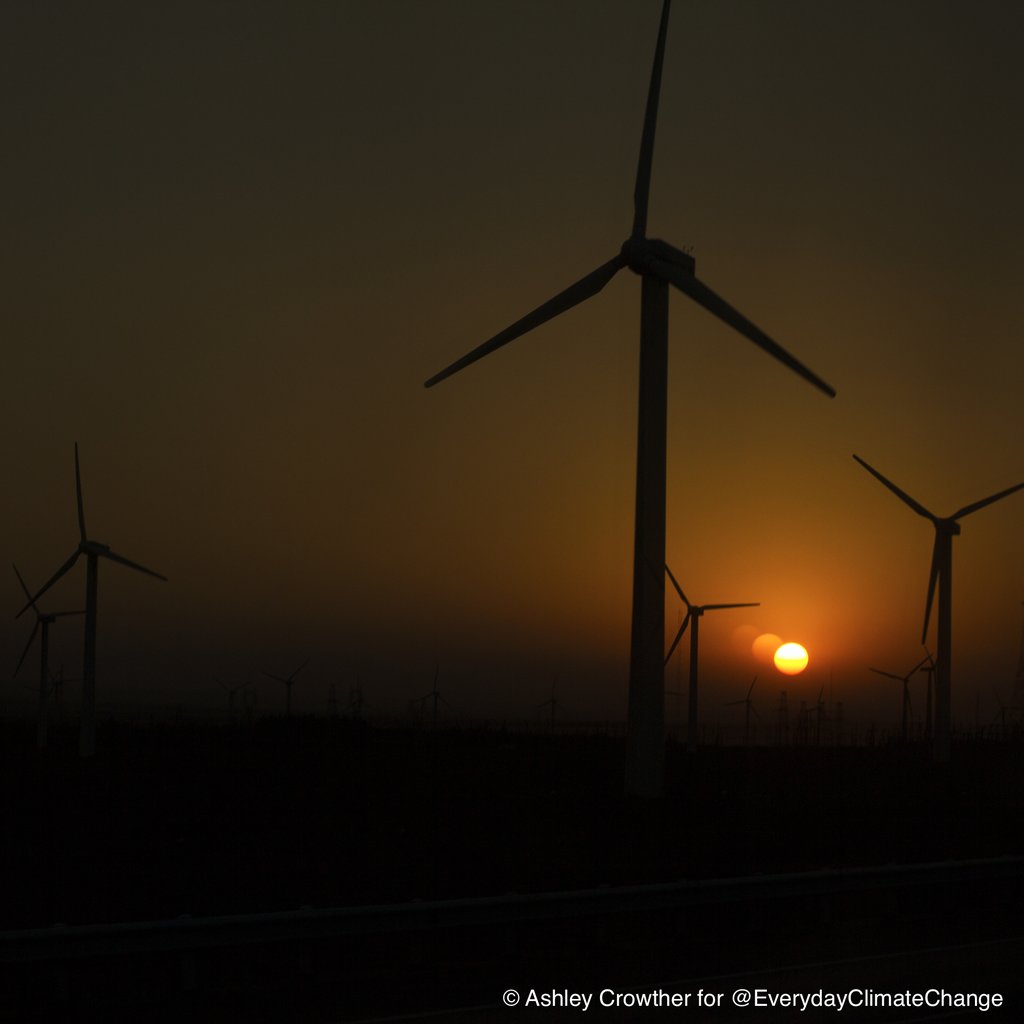
© Ashley Crowther for @EverydayClimateChange
Along the glaciers of Xinjiang, China, wind turbines make for a great view against the backdrop of the sun, which also serves as an apt representation of the future of renewable energy in our world.
According to the REN21 Renewables 2015 Global Status Report, 2015 saw an unprecedented growth of renewable energy power, which accounted for 60% of net additions to the world’s power capacity. In addition, the rapid growth of renewable power and increased energy efficiency measures in several large countries enabled the world’s economy to grow without a parallel rise in CO2 emissions - the FIRST time in four decades!
At WWF and Earth Hour, we believe that a future powered entirely by renewable energy is within reach. Not only is it possible, it would also allow affordable energy for everyone through sustainable means, which is exactly what our planet and its people need! Find out more about what WWF is doing to achieve a 100% renewable world, and do your part by uniting with us for climate action today;)
21 December 2015: It’s up to us to turn the tide on climate change.
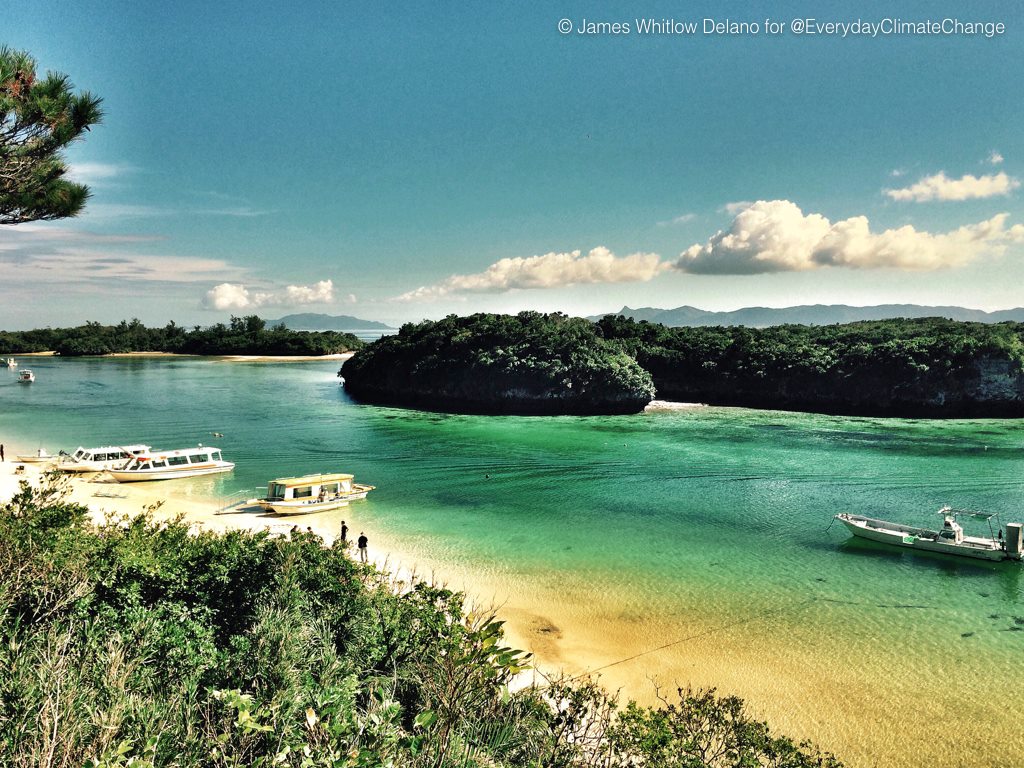
© James Whitlow Delano (@jameswhitlowdelano) for @EverydayClimateChange
The view of these coral reefs along the coast of Kabira Bay in Ishigaki Island, Japan, underscores the natural beauty of our environment and its ability to nurture life on this planet. Coral reefs are extremely important for biodiversity, and provides homes to over 25% of all marine life. In addition to that, they are also vital to people and businesses, supporting livelihoods of up to 500 million people across the world.
But as climate change continues to affect the environment and humankind, the world’s coral reefs are being bleached to death, which is occurring due to global warming and rising temperatures in our oceans.
In fact, as you read this, the world’s third global coral bleaching phenomenon is already taking place, and is expected to impact approximately 38% of the world’s coral reefs by the end of this year and kill over 12,000 square kilometres of reefs. But the most important takeaway is that with your help, we can turn the tide on climate change :)
Join us for Earth Hour 2016 and together, let’s shine a light on climate action and change climate change! - http://ehour.me/cop21-and-beyond
14 December 2015: Love that morning cup of coffee? That’s another reason for you to join us in changing climate change!
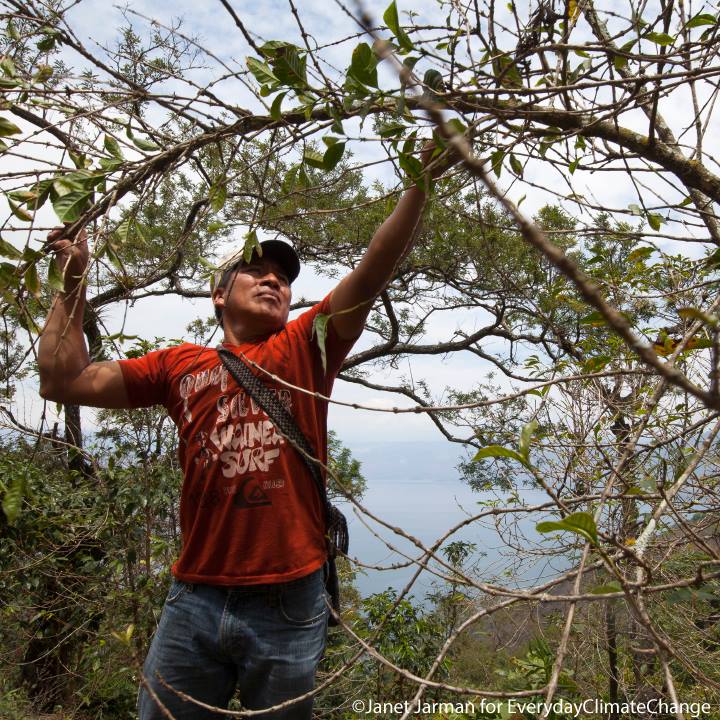
© Janet Jarman for @everydayclimatechange
In Guatemala, a coffee producer picks dead branches off an aging coffee plant, which has become infested with coffee leaf rust disease, attributed to warmer temperatures and climate change.
As climate change continues to impact our planet and its people, consumers will soon start to feel the burn as well - not just in the climate, but also in their supermarkets where the availability and/or cost of agricultural commodities will be affected. These commodities include coffee beans, believed to be one of the world’s favourite beverages, and even bananas, oranges and hazelnuts :o
In fact, by the middle of this century, half of the world’s current coffee cultivation areas could become unusable due to climate change, and increasing water scarcity over the past decade has already led to drastic crop losses in countries like Vietnam and Brazil, where coffee production is an important economic activity.
Thilo Pommerening, climate expert at WWF Germany says: “Changes in weather conditions and extreme weather events such as heatwaves, droughts and floods are already causing losses in yield of many agricultural commodities.”
With those words in mind, there has never been a better time for you to take climate action and change climate change! Join us today and together, let’s build a better future for our planet and humankind - a future that has coffee in it as well ;)
7 December 2015: As climate change and weather events intensify, human health will be put at risk.
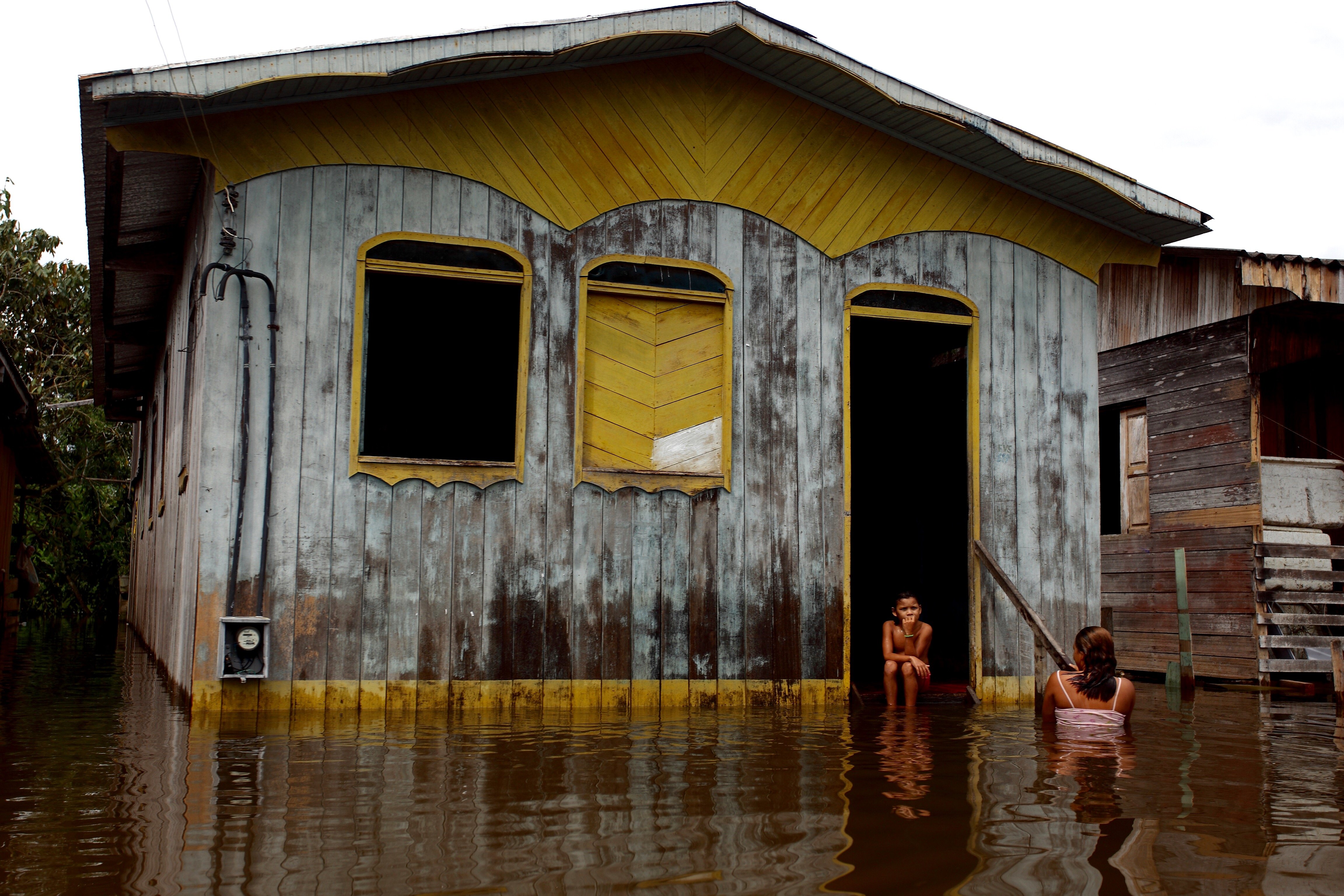
© Rodrigo Baleia (@rodrigobaleia) for @everydayclimatechange.
As temperatures and sea-levels continue to rise, changes in rainfall and runoff will not only cause major changes in species habitats and ecosystems, but also threaten thousands of people who rely on the Amazon for their livelihoods. Taken in Anamã, Brazil, the photo above of a submerged home is thus truly reminiscent of how climate change and intense weather events are already significantly affecting human lives.
In fact, the Intergovernmental Panel on Climate Change (IPCC) suggests that flooding associated with sea-level rise will have substantial impacts on lowland areas such as the Amazon River delta, and the rate of sea-level rise over the last century has been 1.0-2.5 mm per year, and this rate could rise to 5 mm per year.
As climate change leaves its mark across the Amazon region and the occurrence of intense weather events rises, human health will also be jeopardised. For example, climate change and extreme weather events such as floods, may lead to increased outbreaks of vector-borne diseases such as malaria and dengue, and increased outbreaks of infectious diseases such as cholera and meningitis.
But together, we can act for our planet and change climate change! Find out more here and remember to join us in shining a light on climate action :)
23 November 2015: A fisherman prepares his net before returning to the ocean at sunset.

© Matilde Gattoni (@matildegattoni) for @everydayclimatechange.
Witnessing a fisherman in the midst of getting ready for his next catch is indeed a reminder of how much we depend on our oceans and how it has provided for us over the last few centuries. While our seas have once been considered a limitless bounty of food, increasing fishing efforts over the last 50 years as well as unsustainable fishing practices are pushing many fish stocks to the point of collapse. Today, more than 85% of the world's fisheries have been pushed to or beyond their biological limits and are in need of strict management plans to restore them.
In addition to being an important source of protein for billions of people across the world, fishing is also the principal livelihood for millions of people around the world. For example, communities in the Coral Triangle, which includes the waters of countries like Indonesia, Malaysia, the Philippines and more, rely heavily on fishing as a source of income. Unfortunately, the increase in live reef fish trading has expanded rapidly in recent decades, and as much as 50% of reef fish are taken from the water before they’ve had an opportunity to reproduce, which has serious consequences on the marine environment. To make matters worse, climate change is affecting coastal ecosystems through warming seas and ocean acidification.
To combat the problem of over-fishing, which could also lead to economic loss and decreased food security, WWF is working to improve the management of fisheries through implementing policies that assure long-term food security and provide coastal communities with sustainable livelihoods. J
P.S. Looking for more reasons on why our oceans are so vital to our planet’s survival? Click here!
9 November 2015: A Young Boy Plays In A Bed Of Algae In Shandong Province, China.
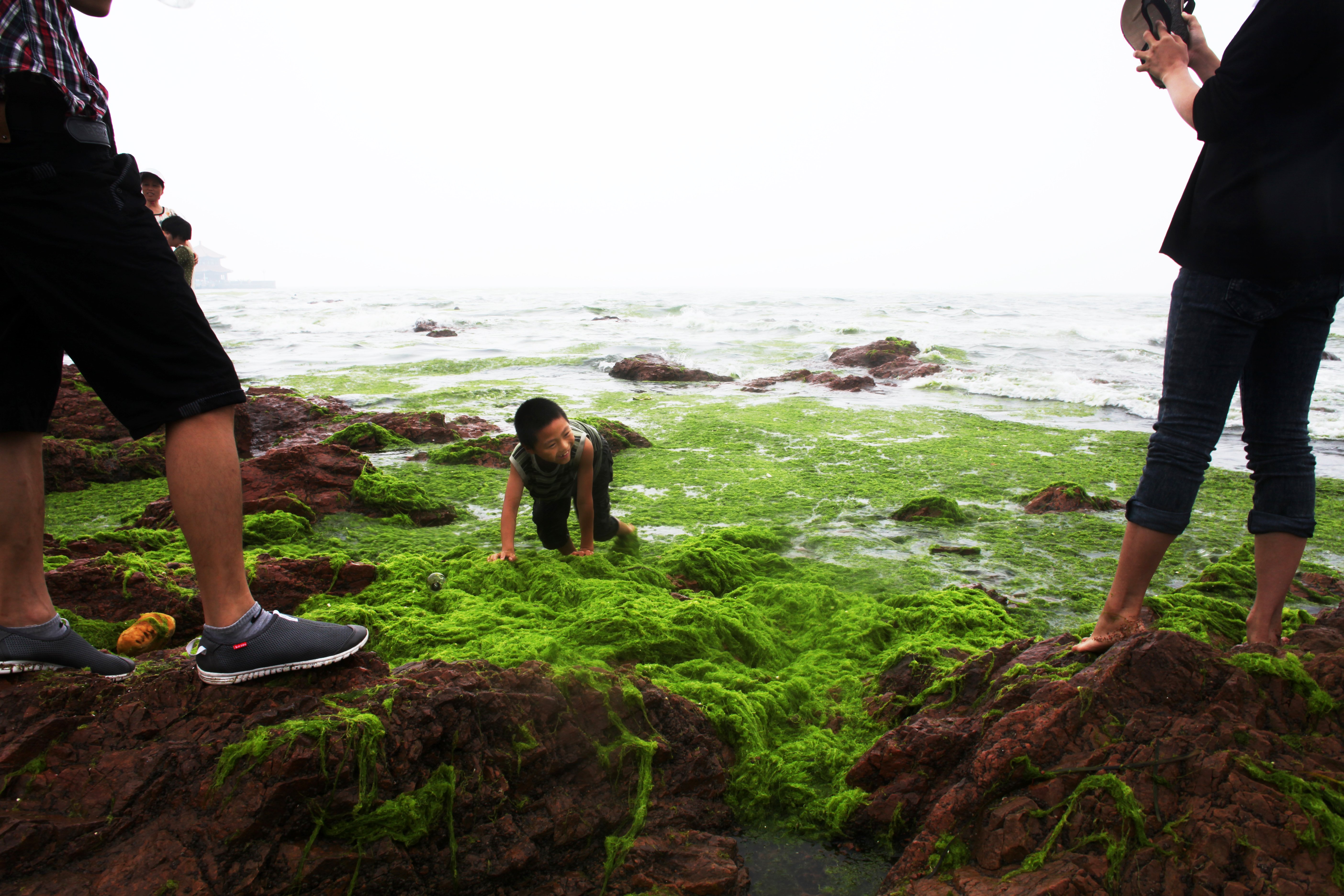
© Katharina Hesse (@hessekatharina) for everydayclimatechange.
For centuries, China has been the world’s most populous nation. Coupled with the unprecedented economic boom that they have witnessed over the last few decades, the growth and consumption of a nation consisting of over a billion people has no doubt impacted the environment immensely, which has become extremely salient in the health of China’s rivers.
Over in Shandong province, a bed of algae along the river doubles up as a playground of sorts for a little child. While it provides for a playful setting and is considered an essential part of life in seas and rivers, algal blooms could become a serious problem if they occur too often, lasts for too long a time and produce toxic substances. In fact, decades of waste discarded into China’s rivers have turned many of them into open sewers and about 40% of the water is unfit for human consumption. Even the water quality of major lakes, including reservoirs and urban lakes is relatively poor, with many suffering algal blooms and eutrophication.
To combat the issue of pollution that is threatening China’s environment and biodiversity, WWF-China is working to pave the way for a more sustainable approach to China’s economic expansion, which includes restoring the Yangtze River wetlands and conducting environmental education. To find out more about their work, click here :)
2 November 2015: The Nile Is Losing Its Magic To Climate Change, Pollution And Other Threats.
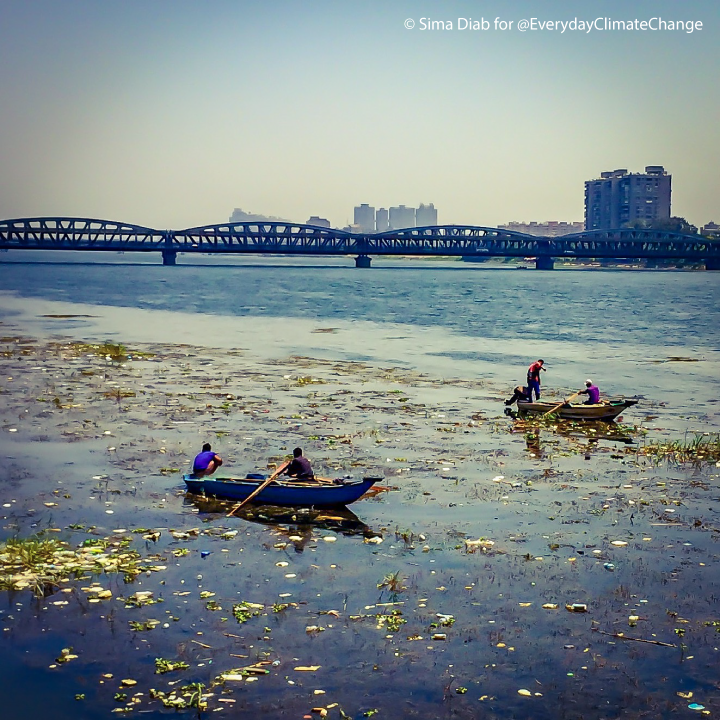
Copyright: Sima Diab (@sima_diab) for @everydayclimatechange.
Known to be the longest river on earth and home to Egypt’s 78 million people, the Nile often conjures up images of ancient history, our endless fascination with early Egyptian civilization and of course, majestic pyramids built for the country’s pharaohs as their final resting places.
Fast-forward to today, the Nile is losing its magic to the effects of pollution, over-extraction of water and development, which are further exacerbated by the impacts of climate change. People have been farming intensively in the Nile river basin for more than 5,000 years but water withdrawal for irrigation has now reached such a high that despite its imposing size, the Nile River no longer reaches the sea during dry periods. In addition, sea-level rise caused by climate change threatens to increase the likelihood of saltwater intrusion into coastal freshwater resources, further reducing the availability of freshwater in the delta region and threatening livelihoods, agriculture, habitats and species that are dependent on the river.
Cutting across the largest number of countries of any basin in Africa, the Nile is a lifeline for numerous communities and WWF is working closely with them and other stakeholders to sensitize and prepare them to the changing situation of the river and its catchment areas. For example, in the Lake Victoria region, WWF is working with school children, teachers and village leaders to encourage participation in environmental management and conservation of the lake.
Find out more about the impacts of climate change on the Nile River here.
26 October 2015: Historic droughts and the impacts of climate change are leaving the Amazon high and dry
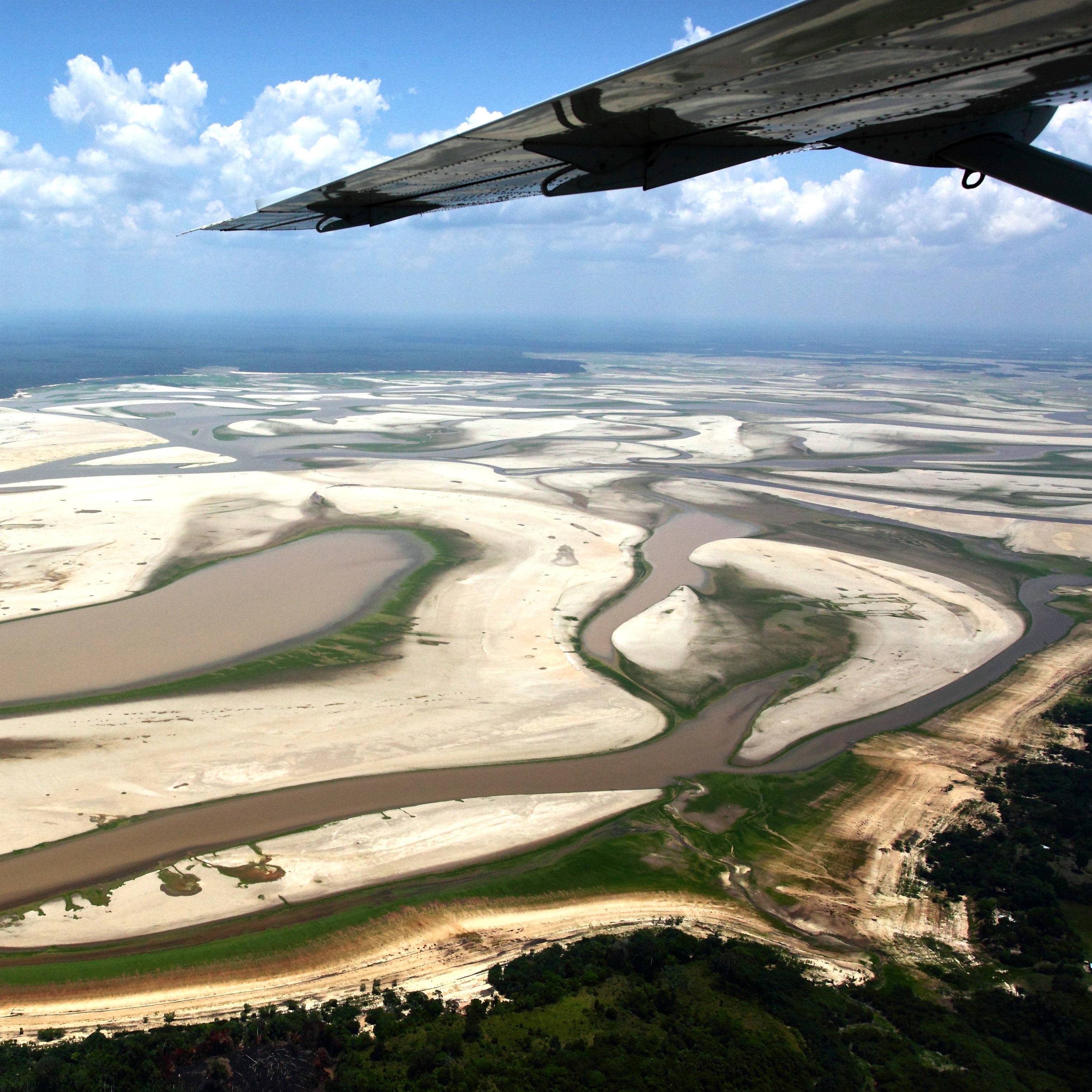
Copyright: Rodrigo Baleia (@rodrigobaleia) for @everydayclimatechange.
Famed for its immense biodiversity, the Amazon is home to half of the world’s remaining tropical forests and 4,100 miles of winding rivers. That’s not all; this stunning terrain, often called the ‘lungs of the Earth’, is responsible for stabilising local and global climate, which means protecting its landscape translates to safeguarding our entire planet as well!
However, the impacts of climate change and severe droughts combined with the effects of unsustainable resource extraction and poorly planned infrastructure, are taking a huge toll on one of nature’s most exceptional biodiversity hotspots, inhabited by one in ten known species on Earth. In the last century alone, warmer temperatures and less rainfall produced droughts of historic proportions in 2005 and 2010, leading to a state of emergency in the Amazon. If rainfall continues to plummet especially during critical dry months, the health of freshwater ecosystems, agriculture and even human health will be severely impacted. The time to act is now.
While navigating your way through the Amazon jungle might be a challenge, doing your part to save it is much less complex - click here to get started! :) You can also do your part to help us change climate change by telling your leader at COP21 that now is the time to put our planet first. Add your voice here and together, let's make climate change history!
19 October 2015: A villager tries to extinguish burning fires with a small hose in Riau, Indonesia.
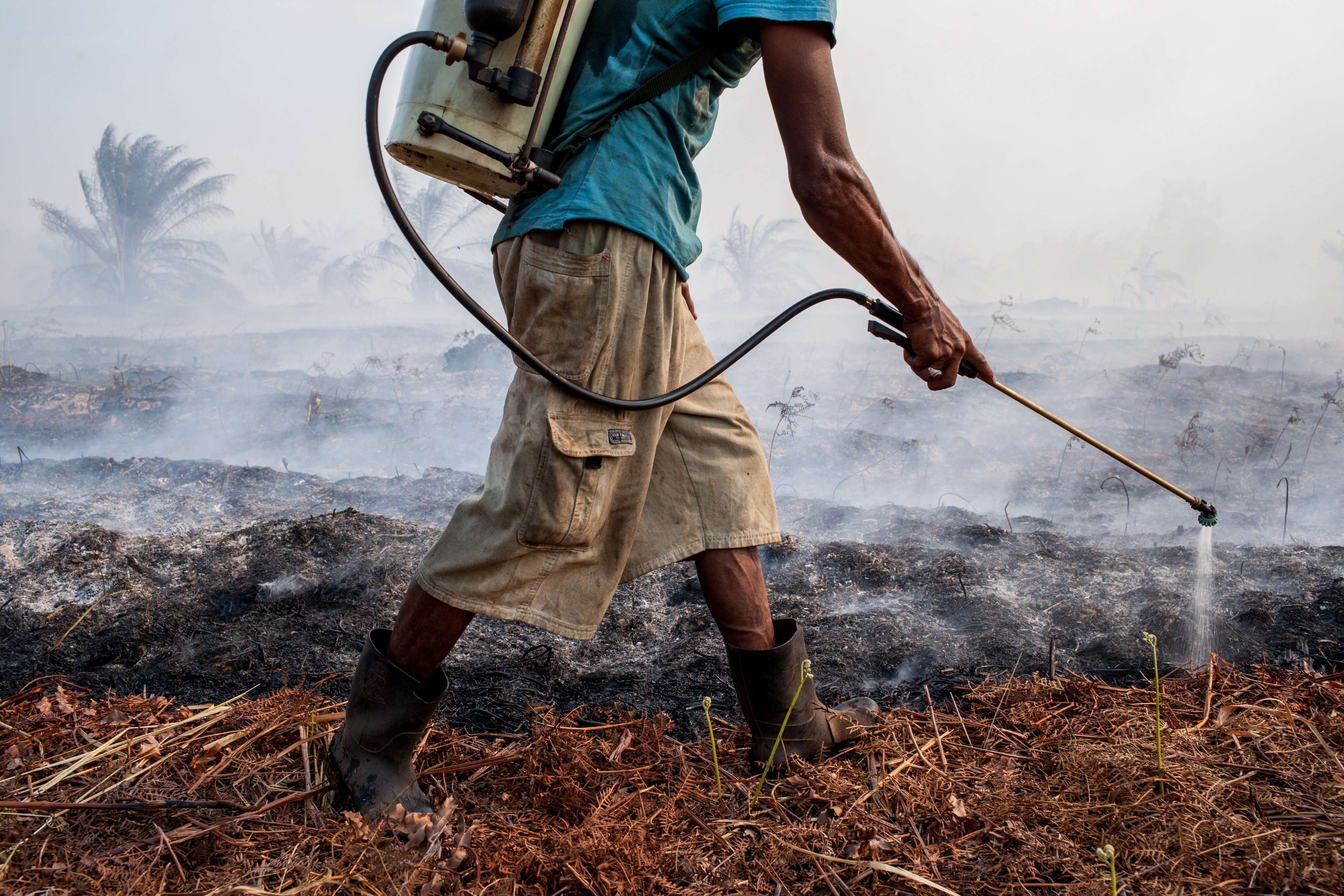
Copyright: Andri Tambunan (@andritambunan) for @everydayclimatechange.
In recent weeks, haze pollution in Southeast Asia has been grabbing media headlines world over, from health concerns to unearthing the causes of the annual occurrence, attributed primarily to illegal slash-and-burn methods of clearing land to meet the growing demand of palm oil, pulp and paper. As governments and organizations gear up to respond to the situation, we wanted to help clear the air on palm oil.
Often seen as the enemy, it is important to understand that palm oil has in fact a higher yield per hectare than most alternatives, also requiring less fertilizers and pesticides. However, unless cultivated responsibly and sustainably, with adequate checks on uncontrolled growth and expansion, it can lead to widespread degradation and deforestation as we see today, impacting our environment and climate change. Thus what we need aren’t alternatives to palm oil, but rather incentives to grow and use sustainable palm oil instead.
With palm oil being present in 50% of all packaged food products in supermarkets today, individuals can use their ‘consumer power’ to demand a switch to sustainable palm oil. Visit WWF-Singapore’s ‘We Breathe What We Buy’ campaign site to raise your voice and encourage companies to only use sustainable palm oil for their products :)
12 October 2015: Wind power turbines serve as the backdrop to ‘chhatris monuments’ dating back to the 16th – 20th centuries in Bada Bagh, India.
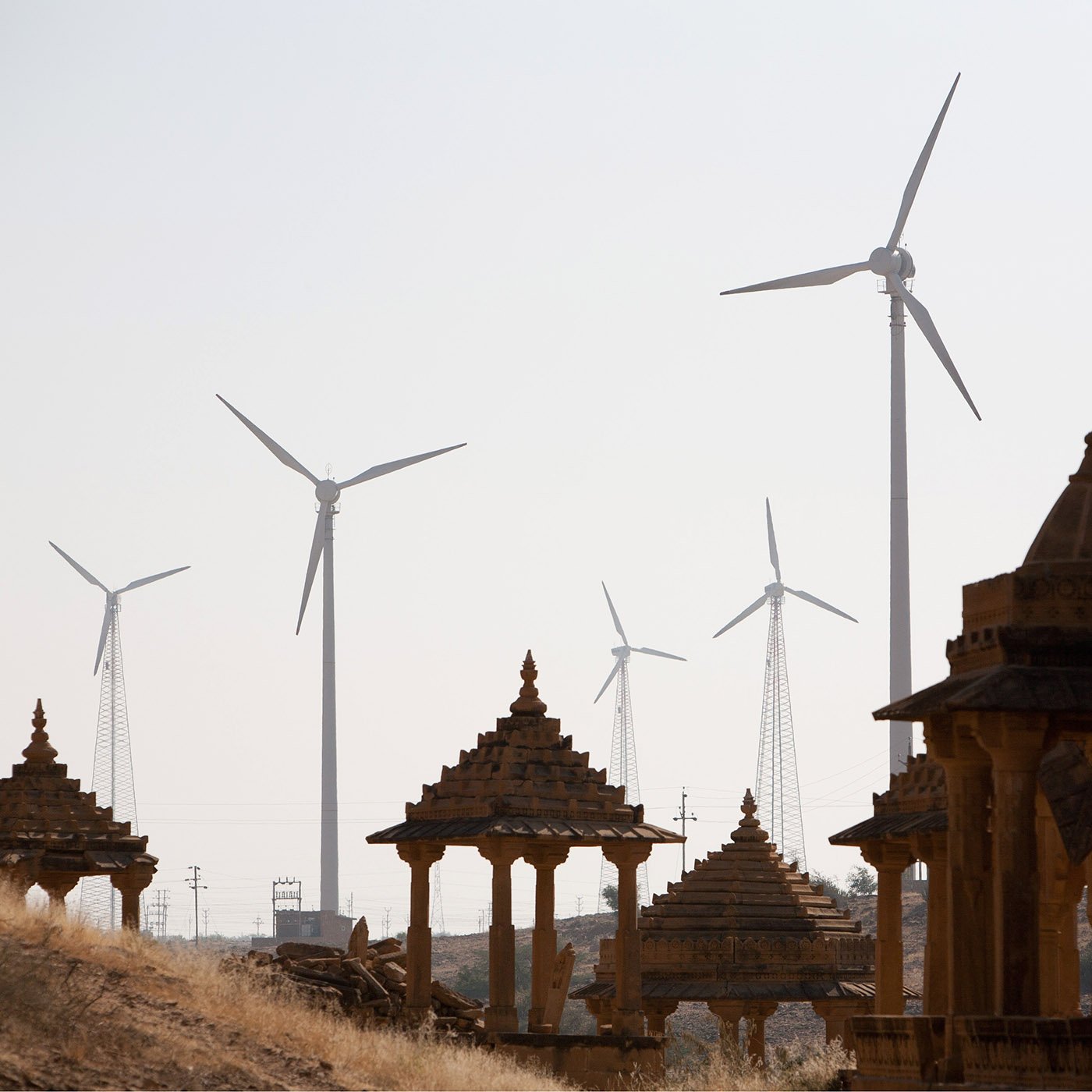
Copyright: Jeremy Sutton-Hibbert (@JshPhtog) for @EverydayClimateChange
In this captivating photo, ‘chhatris pavilions’, commonly used to depict elements of pride and honour in India, stand in front of modern wind power turbines in the state of Rajasthan. The innovative and modern technologies we have today make a future powered 100% by renewable energy entirely possible, and that’s indeed something for us to take pride in and commit towards :)
While fossil fuels accounted for 74% of the total energy consumed in India in 2010, the country is aiming to more than double their use of renewable energy as a share of their electrical mix by 2020 and we hope this is just the start. The upcoming COP21 in Paris presents an opportunity for India and countries around the world to come together and change climate change by showcasing their commitment to clean energy. Find out more about other natural alternatives to fossil fuels here.
5 October 2015: A family navigating through tidal channels in the mangroves of Guinea-Bissau.
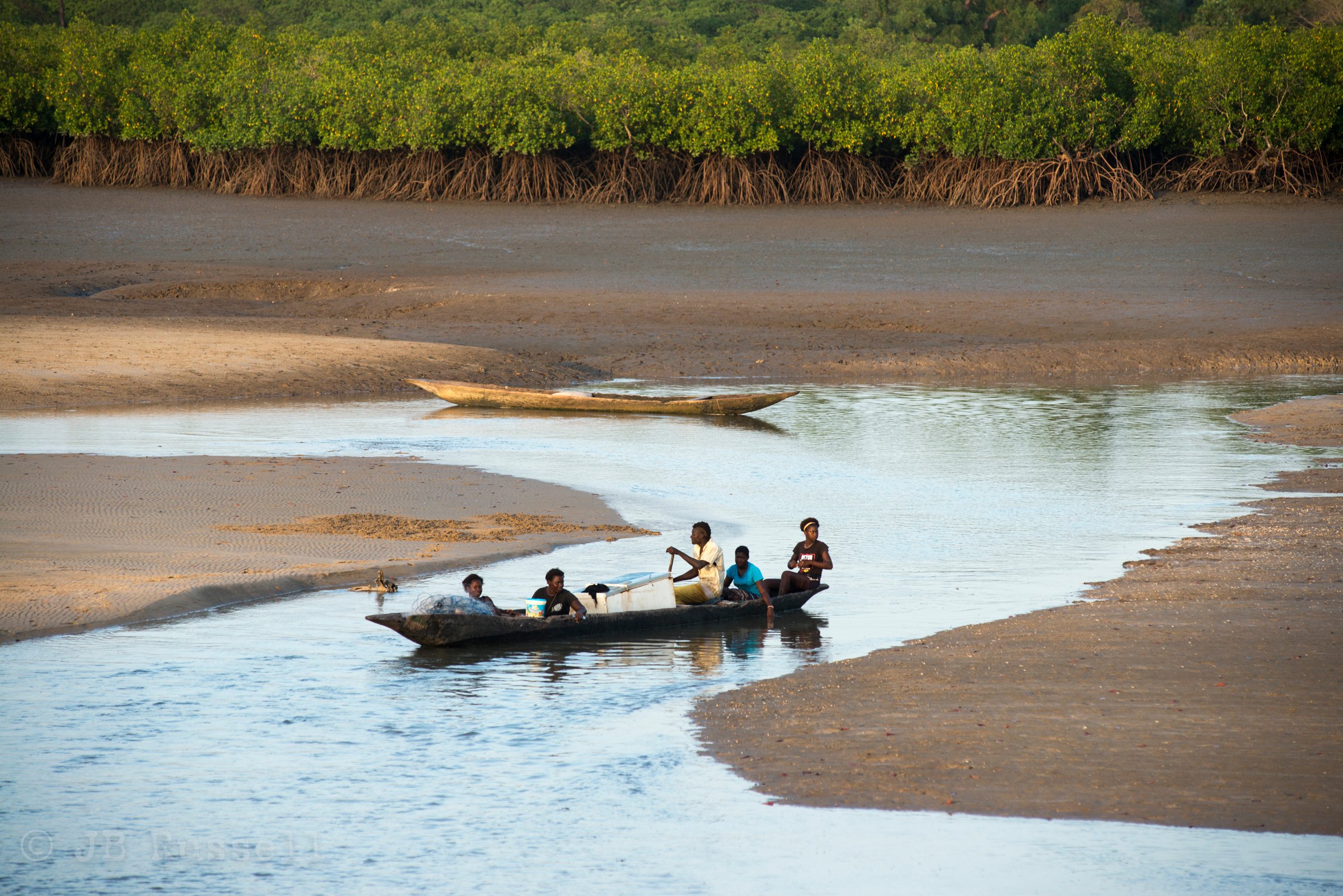
Copyright: J.B. Russell for @EverydayClimateChange
Over the years, mangrove forests have been cleared at a rapid rate - almost 3 to 5 times more than forests to make space for agriculture, human settlements, industrial areas and more. But if we are serious about preserving the health of our oceans and tackling climate change, this needs to stop.
Home to a large variety of fish, crab, shrimp and more, mangrove forests form an essential source of food for thousands of coastal communities around the world. Their dense root systems are a strong barrier against coral reel damaging sediments as well as storms and typhoons, which are expected to increase in frequency and intensity due to climate change. And if that’s not reason enough to love them, they are also home to hundreds of bird species, various dolphin species and the magnificent Bengal tiger!
Find out more about how mangroves are benefiting both marine life and coastal communities here:)
28 September 2015: A father takes in the calming view of the sea with his daughter, while the waves of the Indian Ocean hit the shore rhythmically.
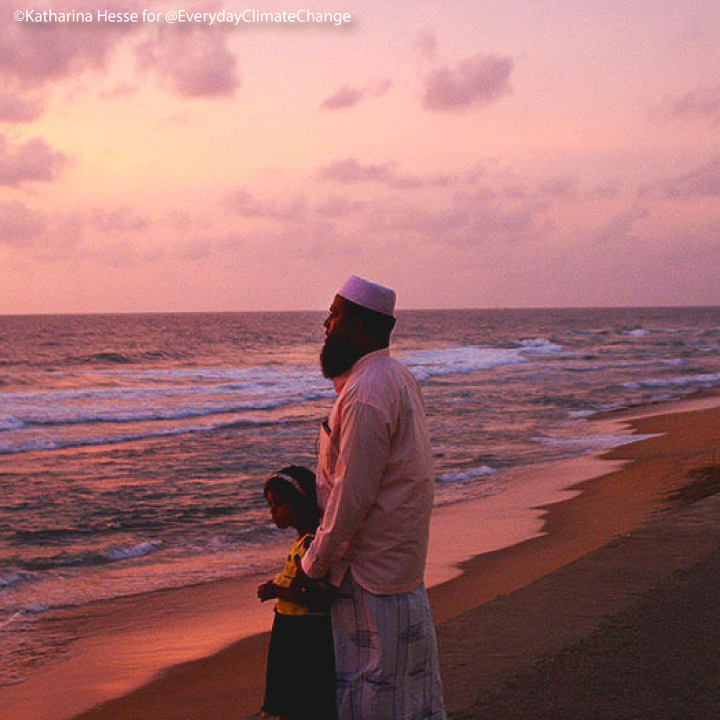
Copyright: Katharina Hesse (@hessekatharina) for @EverydayClimateChange
Did you know the ocean is home to 99% of our planet’s living space but unbeknownst to many of us, they have been plundered to such an extent by human activity that marine life has plummeted by almost 50% since 1970!
From overfishing and resource depletion, to greenhouse gas emissions causing ocean acidification, the health of our seas has deteriorated in the last few decades. However, we believe together we can turn the tide and revitalise our oceans by moving towards sustainability:)
WWF has been working to ensure that the economic development of the ocean contributes to lasting prosperity and resilience and you can help too! From spreading awareness (by sharing this post for example!) to opting for sustainable seafood or supporting your local WWF’s conservation projects, there’s so much you can do to create a ‘wave of change’- it all starts here.
21 September 2015: Children enjoy a baton race in Enewetak, an atoll in the Marshall Islands.
_0-4.jpg?width=5616&height=3744&name=ColeenJose_MarshallIslands_Enewetak_2015%20(101%20of%20226)_0-4.jpg)
Copyright: Coleen Jose (@coleenjose) for @EverydayClimateChange
While climate change continues to be seen as a distant reality in many parts of the world, citizens of the Small Island Developing States (SIDS) like the Marshall Islands pictured above are faced with the unimaginable truth that a few years from now, their land itself may become a distant memory. As the world continues to warm, the Marshall Islands, already reeling under the effects of climate change, will come to experience more impacts on their livelihoods and economy, ranging from rising sea levels to increased frequency and intensity of natural disasters like typhoons and in turn, food and health issues.
However, the Marshall Islands are far from calling it a day. Their bold climate plan submitted to the UN ahead of COP21 shows the true meaning of climate leadership. That a country responsible for less than 0.00001% of global emissions is showing such resolve should be an example for all other countries to follow suit. In the words of the Marshall Islands’ Minister of Foreign Affairs, Tony de Brum, “Our message is simple: if one of the world’s smallest, poorest and most geographically isolated countries can do it, so can you.”
(P.S. Everyday Climate Change is running a crowdfunding campaign to raise awareness on climate change at the Photoville exhibition in New York till the end of September. To know more, click here.)
14 September 2015: On Thin Ice

Copyright: Balazs Gardi (@balazsgardi) for @EverydayClimateChange
Blanketed by vast expanses of ice, snow and valleys, Greenland makes for a heavenly landscape. And with a gorgeous view like that, it’s difficult to digest the reality that the Arctic is warming at a rate of almost twice the global average, due to climate change.
Since the 1970s, sea ice has decreased by 14%. Today, it continues to deplete at a rapid rate and poses a huge threat to polar bears and the rich biodiversity of the Arctic region. As the Earth continues to heat up and the ice disappears, scientists estimate that two-thirds of polar bears could be wiped out by 2050.
That’s not all. As snow and ice melt, the ability of the Arctic to reflect heat back to space is reduced, accelerating the overall rate of global warming. Find out more on why climate change in the Arctic affects us all, and act now to change climate change!
7 September 2015: Summer in the Spiti Valley of the Indian Himalayas

Copyright: Ashley Crowther (@ashleycrowtherorg) for @EverydayClimateChange
The highest mountain range in the world, the Himalayas are a majestic reminder of the wonders of nature and our planet. Home to stunning landscapes and iconic biodiversity, the mountains are also the source of six of Asia's largest river systems including the Yangtze, Indus and Ganges- lifelines for millions of communities downstream.
However, imposing as they may be, the Himalayas are also threatened by climate change. Melting glaciers and subsequent flooding as well as changes in seasonal and precipitation patterns are affecting millions dependent on the mountains for freshwater for lives, livelihoods and biodiversity. WWF is working with communities in India, Bhutan and Nepal to harness indigenous knowledge and practices and build climate resilience. From water harvesting to draining and irrigation of glacial lakes and sustainable agricultural practices, WWF is on the ground to preserve the 'Water Towers of Asia'.
31 August 2015: Fishermen in traditional seagoing pirogues arrive on the beaches of Kafountine in the Casamance region of Senegal.
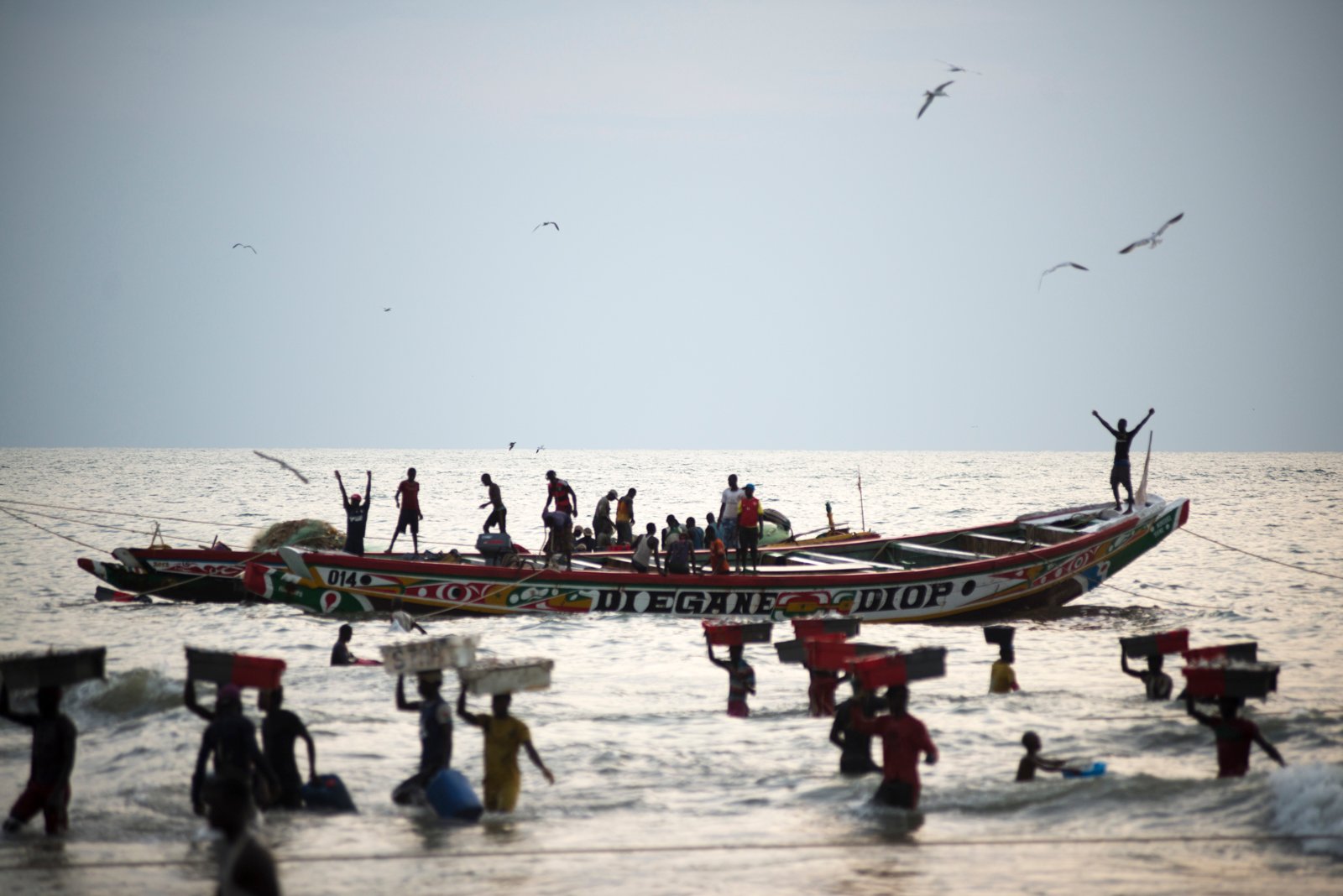
Copyright: J.B. Russell (@jbrussell) for @EverydayClimateChange
The ocean is not only a photographer's delight but an invaluable resource that millions depend on for food and livelihoods. It is home to 99% of our planet's living space and underneath that magnificent exterior, it holds the key to turning the tide on climate change.
From producing half the oxygen we breathe and absorbing 30% of the carbon dioxide we produce, our oceans are a natural defence against climate change- but also amongst the first and worst impacted. Find out more about how climate change is impacting 71% of our planet here.
(P.S. Everyday Climate Change is running a crowdfunding campaign to raise awareness on climate change at the Photoville exhibition in New York this September. To know more, click here.)
24 August 2015: Running to a cleaner future on the tracks of Cathkin Braes, Glasgow, Scotland.
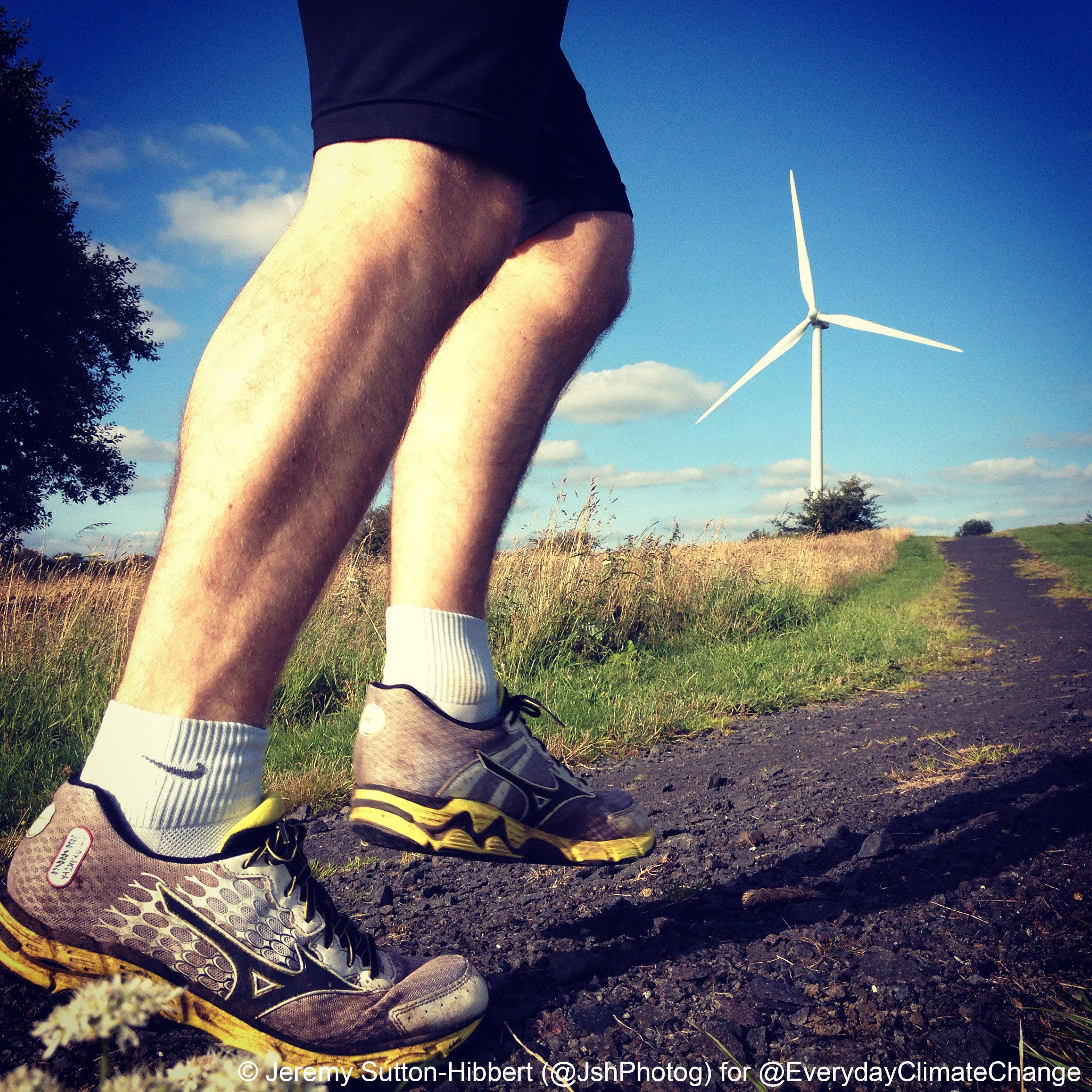
Copyright: Jeremy Sutton-Hibbert (@JshPhotog) for @EverydayClimateChange
In July 2015, wind energy in Scotland provided 36% of Scotland’s entire electricity needs, according to new figures from WWF-Scotland. “It may have been amongst one of the wettest and windiest months in decades, but July also turned out to be a belter of a month for wind power in Scotland. Thanks to a combination of increased capacity and much windier weather, output from turbines was up more than half compared to the same period last year," said Lang Banks, Director, WWF-Scotland.
Wind and tidal wave energy is surging in Scotland, helping the nation to reduce climate-wrecking emissions. To know more about Scotland's vision to secure clean, renewable and secure electricity by 2030 and how WWF is helping, click here.
17 August 2015: Solar panels atop homes in a small mountainous village called Demule high up in the Indian Himalayas.
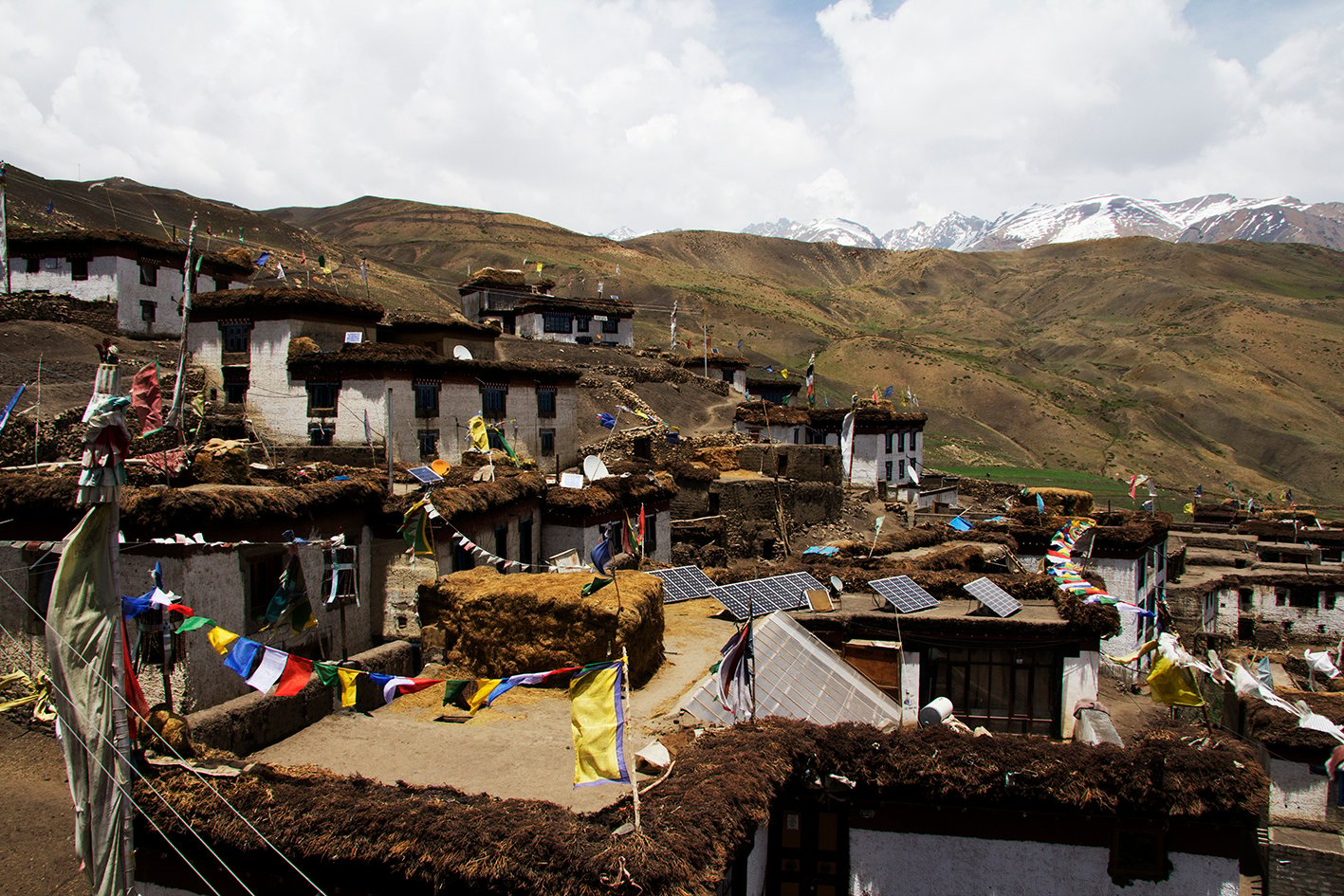
Copyright: Ashley Crowther (@ashleycrowtherorg) for @EverydayClimateChange
We are glad to see solar energy scale new heights- quite literally as Demule sits 4600m above sea level! To avoid the very worst impacts of climate change, it is essential that the world transition from its current unsustainable energy paradigm to a future powered entirely by renewable energy supply. WWF’s groundbreaking energy study - The Energy Report - shows that this future is within our reach, and provides vital insights into how it can be achieved.
10 August 2015: A gigantic cedar tree in the Chouf mountains in Lebanon.
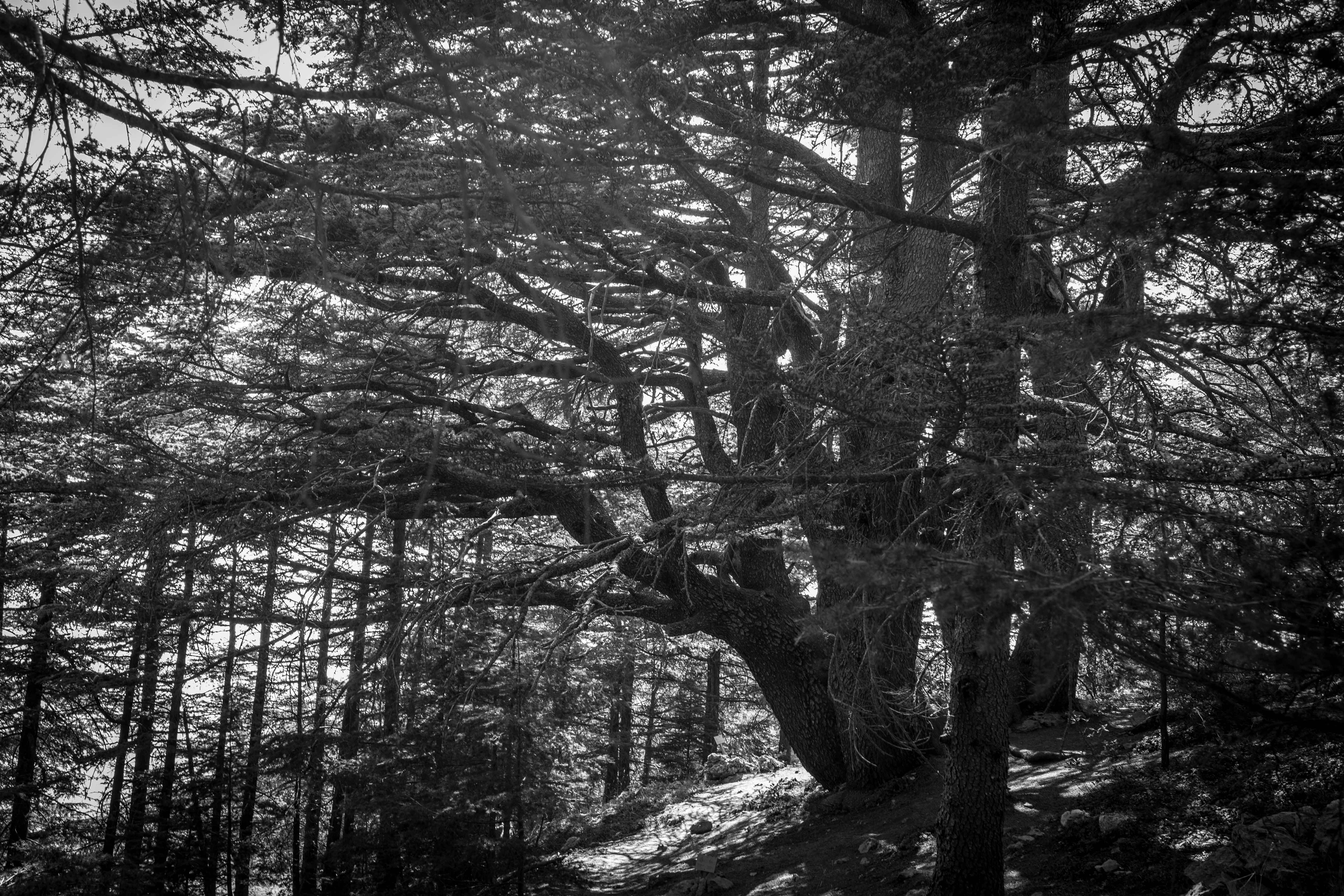
Copyright: Sima Diab (@sima_diab) for @EverydayClimateChange
Lebanon is known worldwide for its forests, especially its majestic cedars, also featured on its national flag. Forests once covered all of the country's mountains but forest fires, overgrazing and degradation has reduced forest cover to 5% today, with cedars specifically surviving in 12 fragmented patches only.
WWF is working closely with local partners like conservation group AFDC, communities and volunteers to fight forest fires, replant trees and encourage sustainable livelihoods which both protect forests and provide income to families. Together, around 250,000 trees have been planted in 10 years signaling a new seed of hope for the incredible green giants- and in our efforts to change climate change. To know more about how forests can help tackle our planet's biggest environmental challenge yet, click here.
3 August 2015: Sabino Gualinga, spiritual leader of the Sarayaku community living deep in the Ecuadorian Amazon.
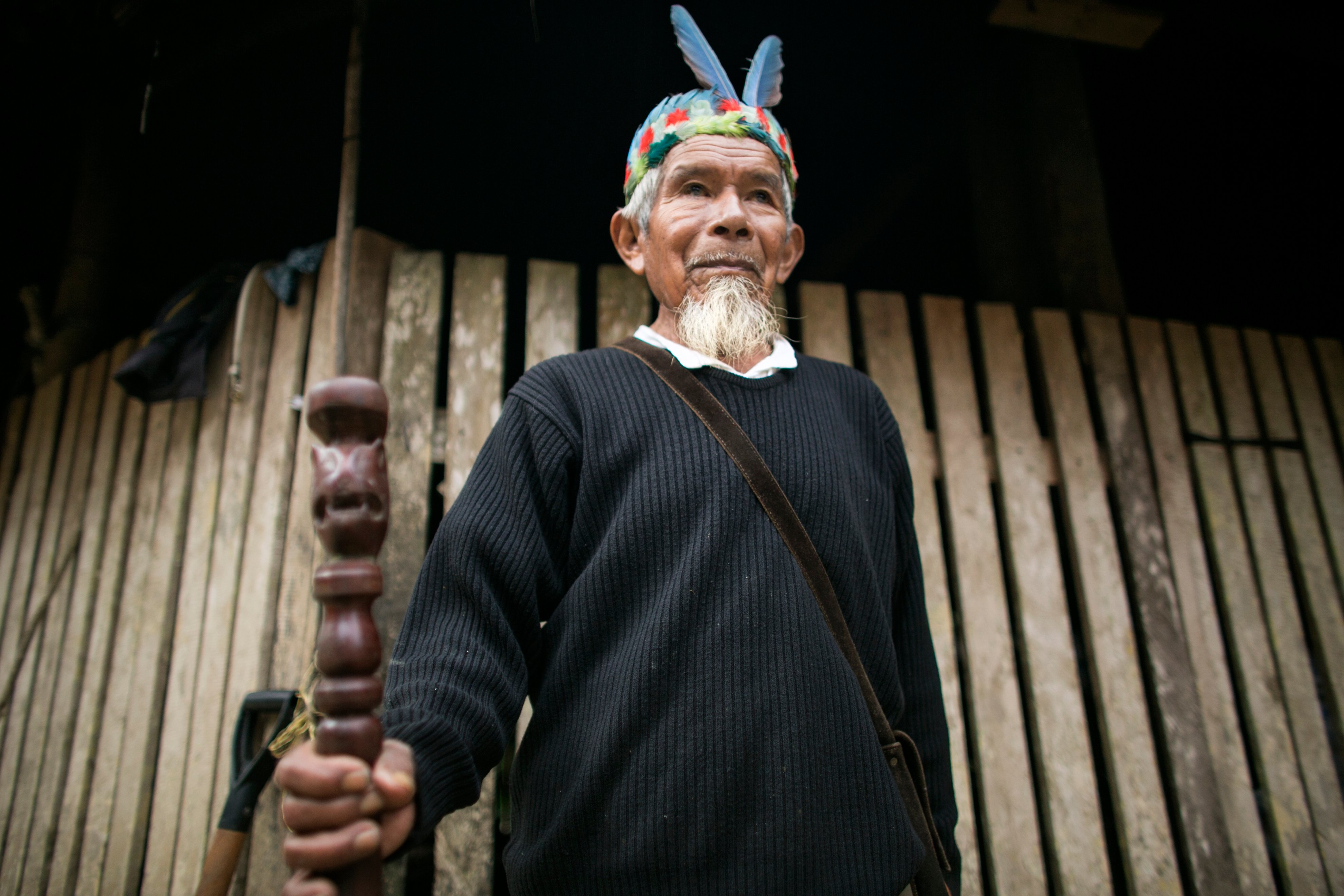
Copyright: Caroline Bennett (@carobennett) for @EverydayClimateChange
"The breath of life comes from the forest. We live within her, she gives us wisdom and positive visions so that we may exist." These simple yet poignant words by Sabino Gualinga perfectly capture the importance of forests for communities and humanity worldwide. Often called ‘the lungs of the Earth’, forests are the largest storehouse of carbon after the ocean. Home to thousands and thousands of species of flora and fauna, forests also provide fuel, housing and nourishment to billions of people.
Today, these biodiversity hotspots are threatened by degradation and deforestation and all of us- governments, companies and individuals- need to act urgently to avoid irreversible losses of biodiversity and runaway climate change. In this article, WWF's Peter Graham, Leader of the Forest and Climate Programme, explains how our planet's magnificent forests can help change climate change and how YOU can be a part of the efforts!
27 July 2015: The Mekong delta, where nearly half of Vietnam’s rice is grown.
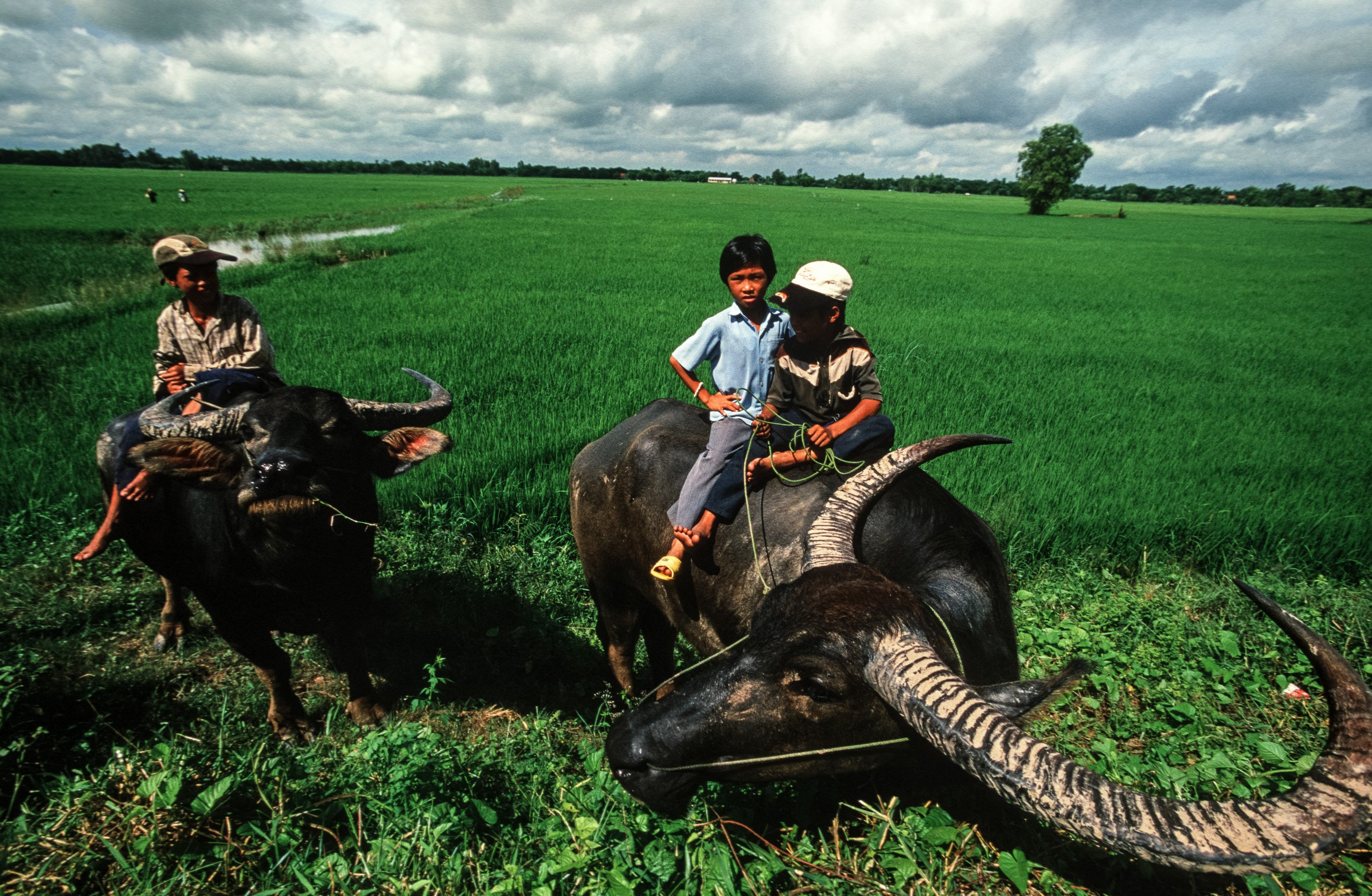
Copyright: Suthep Kritsanavarin (@suthepkritsanavarin) for @EverydayClimateChange
The Mekong delta is at the heart of Vietnam's rice producing region, a massive source for the staple consumed by millions inside and outside the country. However, climate change may sow the seeds of a very different future. The 2008 UNDP Human Development Report estimates that a 2 degree Celsius rise in global temperatures could result in a loss of 45% of Vietnam's agricultural land due to the subsequent rise in sea levels.
WWF-Vietnam is working with ministries and departments to study, address and mitigate the impact of climate change in Vietnam- particularly the Mekong Delta, one of the three worst affected deltas in the world. The team is also engaging the public and corporates through campaigns like Climate Savers and Earth Hour to enhance climate awareness and action. Find out more about WWF in Vietnam here.
20 July 2015: The Mont Blanc Massif and Mer de Glace (Sea of Ice) Glacier in the French Alps.
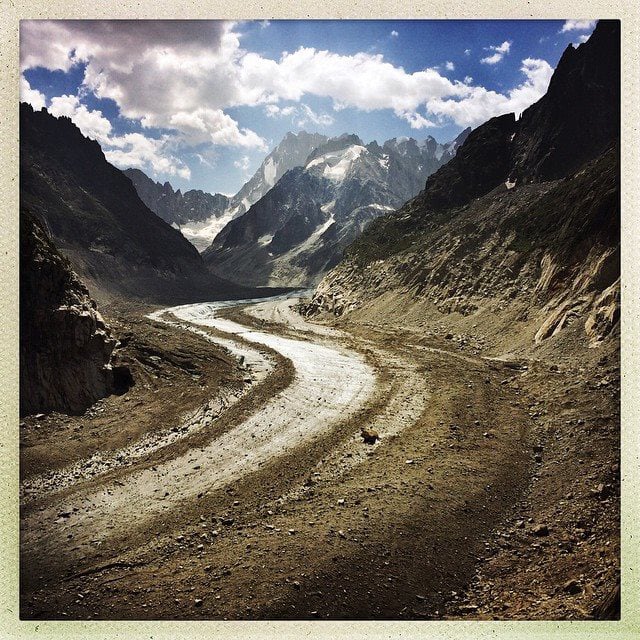
Copyright: James Whitlow Delano (@jameswhitlowdelano) for @EverydayClimateChange
Did you know that the Alps have warmed by 1.5 degrees Celsius in the last century alone? The rise in temperatures has caused all Alpine glaciers to recede (including the Mer de Glace glacier pictured here above) posing a very serious threat to Alpine nature.
For example, glacier recession has led to an upward migration of Alpine plants at a rate of 0.5 - 4 m per decade. In the long run, lowland plants will displace Alpine species to ever-higher altitudes until they simply have nowhere to go at all, effectively forcing them into extinction! Read more about the Alps and the environmental challenges the region faces here.
13 July 2015: “We used to carve our canoes out of 1 single big tree, this here is the last one left on the island”- Mentawai Shaman on Siberut Island, Indonesia
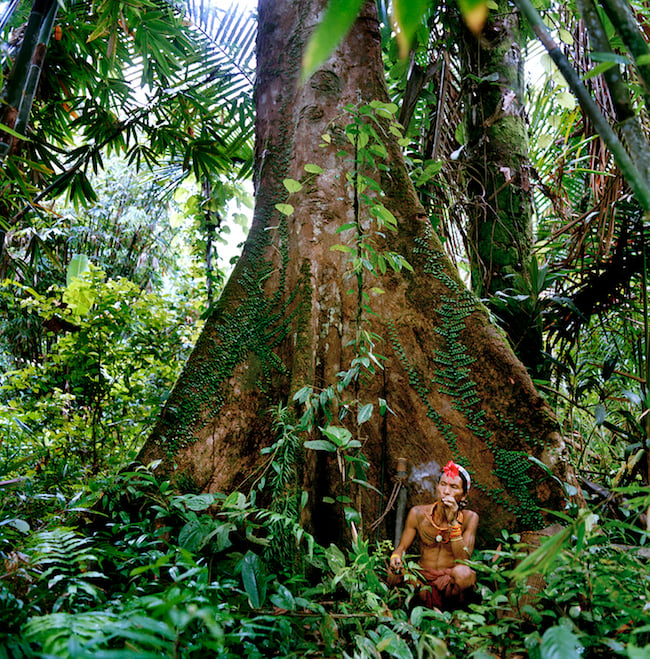
Copyright: Philipp Engelhorn (@philipp_engelhorn) for @EverydayClimateChange
Forests are vital to the planet, providing critical ecosystem services and livelihoods to people and shelter to wildlife. They also serve as natural guardians against climate change, the biggest environmental challenge our planet faces today, as the trees and plants absorb carbon dioxide (one of the primary greenhouse gases) during photosynthesis.
But deforestation is increasingly threatening these "lungs of the earth." Between 2000 and 2010, 13 million hectares of forest - the size of Greece - were lost each year due to deforestation and forest degradation. Furthermore, a new WWF Living Forest Report shows that we could lose up to 170 million hectares of forest by 2030 if we fail to act now.
Help spread the word and protect the green giants- share this post with your friends and family today!
29 June 2015: One afternoon in February, children swim in the lagoon side of Majuro, capital of the Marshall Islands.
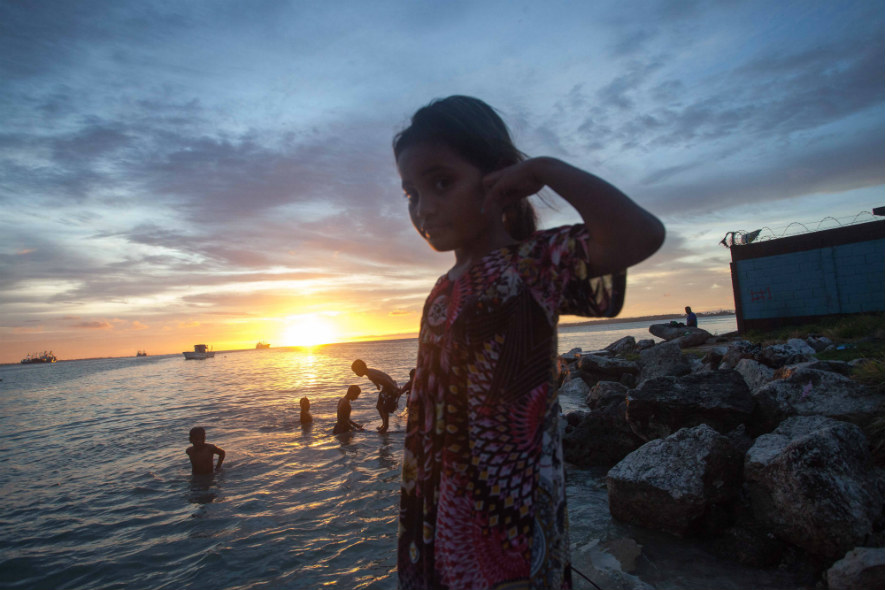
Copyright: Coleen Jose (@ColeenJose/@GroundTruth) for @EverydayClimateChange
The Marshall Islands is among the low-lying island states that have been listed by the World Bank as most at risk from sea level rise due to climate change. As temperatures rise, seas will absorb more heat from the atmosphere, causing them to expand and rise. Ice sheets, such as those in Greenland and Antarctica, and land glaciers will also continue to melt and further increase the level of the seas.
It is projected that global warming will cause sea levels to rise by as much as 5 mm per year over the next 100 years. Several Pacific island states are threatened with total disappearance- 2 uninhabited islands in the Kiribati chain have already disappeared due to sea level rise.
"The older generation tells us that certain parts of the reefs were above water when they were young. Every year the storms are getting worse, both more intense and destructive.” said Hon. Tom D. Kijiner from the Marshall Islands at the first-ever COP summit in Berlin, Germany back in April 1995. Today 20 years on, the Marshall Islands along with other Small island developing states (SIDS) is urging world leaders to act on climate at the upcoming COP21 scheduled to take place in Paris in December. Add your voice to support climate action.
22 June 2015: Charcoal makers work in the sandy forest in Madagascar in 2010, an area that was dense with trees twenty years ago.
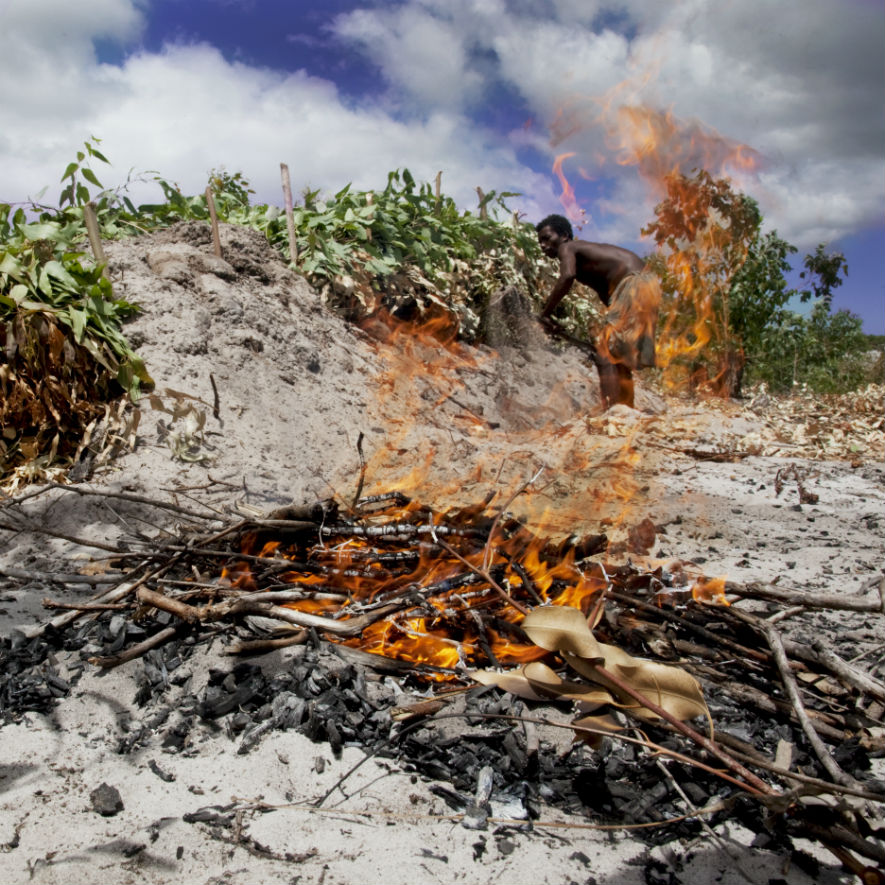
Copyright: Ed Kashi (@edkashi/viiphoto) for @EverydayClimate Change
Deforestation, which can lead to desertification, water resource degradation, biodiversity erosion, habitat and soil loss, and not to mention release significant emissions, is a major challenge in Madagascar, a country that finds itself on the frontlines of climate change.
WWF-Madagascar works with the government and local communities to reduce deforestation, promote renewable energy and safeguard and grow the island's rich fringe of coastal mangroves - globally important areas in terms of biodiversity and carbon storage. Over the past three years, the WWF team has also been using the power of Earth Hour to spread awareness and access to fuel-efficient stoves amongst families. To date, over 5,000 ‘Fatana Mitsitsy’ stoves have been distributed, helping cut the families’ reliance on wood by half and saving one of the country’s most precious resources- its forests! Watch how ‘Fatana Mitsitsy’ stoves can fuel hope for a brighter future.
15 June 2015: A man washes his hands after crossing the Dnipro river on a hot summer day in Kiev, Ukraine.

Copyright: Amnon Gutman (@gutmanen) for EverydayClimateChange
In the Danube-Carpathian region, stretching from Germany in the west to Romania and Ukraine in the East and from Poland in the north to Bulgaria in the south, the main impact of climate change is expected to manifest itself as climate anomalies, with increasing frequency and severity of extreme weather events, including both droughts and flooding. Parts of southern Hungary and northern Serbia are likely to experience desertification. Many areas, especially in Bulgaria, could experience severe water shortages. Snow cover and the number of cold days will decrease, with farreaching consequences not only for the availability of water, but also winter tourism. Ski areas below 1,500 meters -- including most ski areas across the region -- will be unviable. Within the next decades, over a quarter of the species of flora and fauna in the region will likely face extinction. Learn how WWF is working to protect and preserve this outstanding natural area.
5 June 2015: 16 fishermen pull two kilometers long fishing net on the eastern coast of Bangladesh.

The ocean is a lifeline for coastal communities in Bangladesh. It is a source of food and livelihood for millions and the vast mangroves also offer protection from the intense storms and cyclones the region is known for. But climate change and rising ocean temperatures are threatening the delicate aquatic ecosystem- and in turn, the lives of the many species and people that depend on it. Find out more about how our oceans are on the front lines of climate change in this blog post by John Tanzer, Director, Global Marine Program, WWF-International.
1 June 2015: Harvesting rice the old way in Mindanao, Philippines.
The Philippines is considered one of the world's most vulnerable countries to climate change. Sitting right in the typhoon belt, now more powerful than ever due to climate change, the archipelago has seen entire villages being devastated. With impacts ranging from extreme weather events to droughts and food scarcity, climate change is now constant reality that many Filipinos have to face.
WWF's Climate Change and Energy Programme focuses its work on increasing the resilience of vulnerable areas like the Philippines through local stakeholder engagement, capacity building exercises, public-private co-operation, and policy-making. The WWF team in the Philippines has been working tirelessly with various governmental organisations and key agencies to ensure that adaption measures are implemented on the ground. Through Earth Hour, WWF aims to engage and empower Filipinos to be a part of these solutions and efforts. As Benigno Aquino III, President of the Philippines, said, "through campaigns like Earth Hour, all of mankind shows us that no challenge can daunt us."
25 May 2015: The Zaafarana wind farm in Egypt
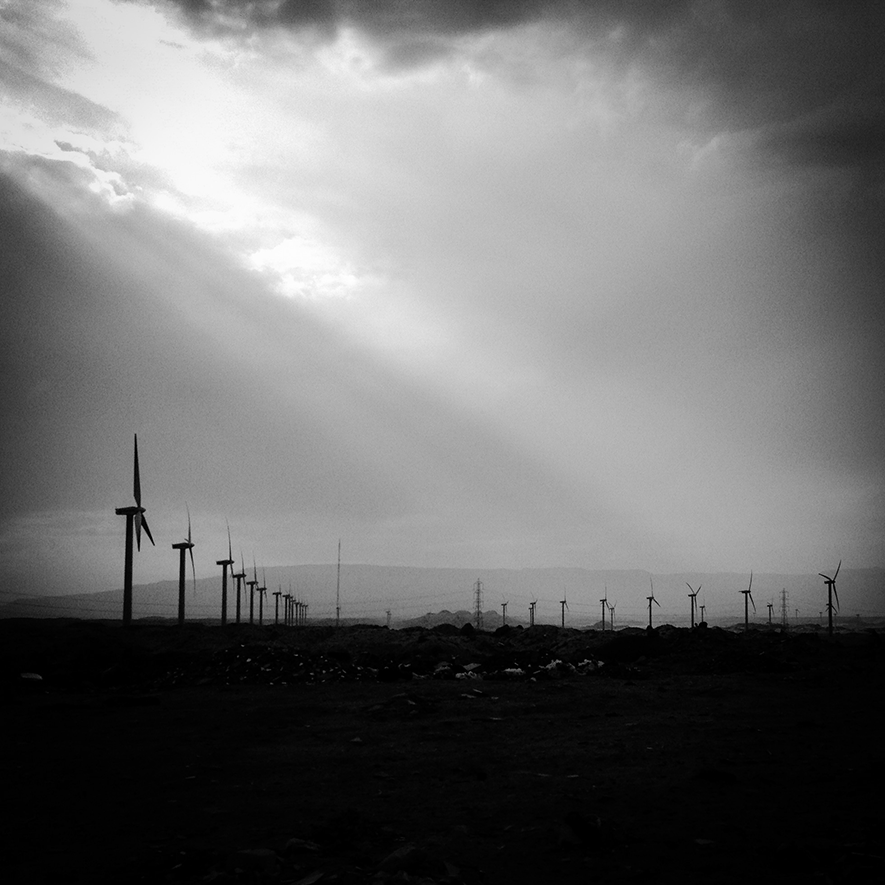
Copyright: Sima Diab (@sima_diab) for EverydayClimateChange
The Zaafarana wind farm project in Egypt, is one of the world's largest onshore wind farms. Located within Egypt's best developed wind region, the farm utilises the Red Sea Coast's heavy winds. With an increasing need for energy and electricity, Egypt has suffered from large scale black-outs over the years, as its growing population places a heavy strain on the ageing electrical grid. Currently listed as the largest consumer of oil and natural gas in Africa, the Supreme Council of Energy adopted an ambitious resolution in 2007 to cover 20% of the country's needs with renewable resources by 2020.
Like Egypt, the world needs to start transitioning from its current unsustainable energy paradigm to a future powered entirely by renewable energy supply. Only by making such a transition will we be able to avoid the very worst impacts of climate change. WWF’s groundbreaking energy study - The Energy Report - shows that this future is within our reach, and provides vital insights into how it can be achieved.
18 May 2015: Women from the Nere Walo co-operative working in their vegetable garden.
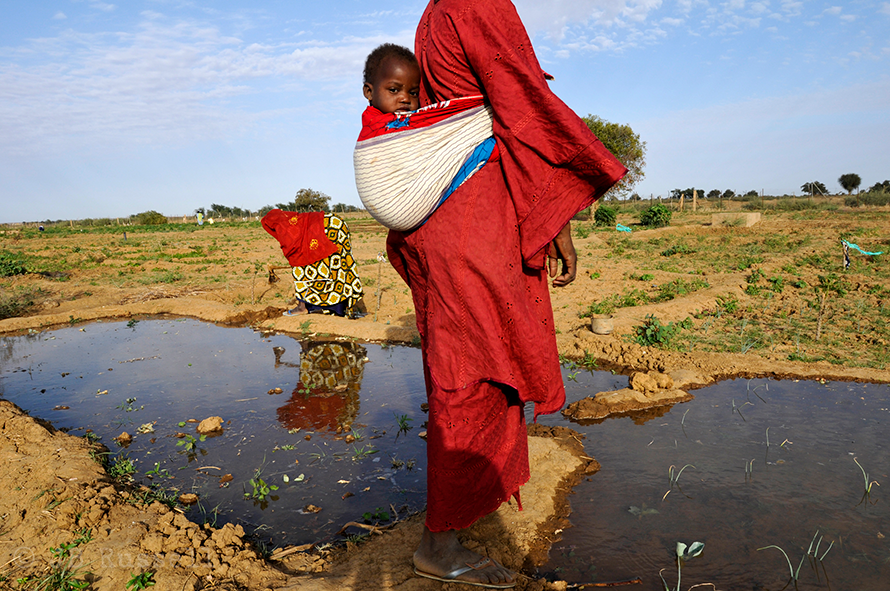
Copyright: J.B Russell (@jbrussell) for EverydayClimateChange
An irrigation project that pumps water from the nearby Senegal River into the vegetable plots has allowed the Nere Walo co-operative in Mauritania to thrive, despite severe droughts and erratic rain patterns, a reality of climate change for millions across the Sahel region of West Africa. The fruits and vegetables harvested by the co-operative not only meet the food needs of the community, but also generate much-needed income for the women of the co-op and their families. The income from the sale of surplus produce empowers the women and gives them a larger say in decisions concerning their community, a role traditionally reserved for the male members of the family. You may call it girl power or the power of change, but what we see here is just how far-reaching the impact of the crowd can be — from changing attitudes to changing climate change, together we can make a difference.
11 May 2015: Boatmen out on the Sundarbans, Bangladesh

Copyright: Arati Kumar-Rao (@aratikumarrao) for EverydayClimateChange
The Sundarbans are on the front lines in the fight against climate change in Bangladesh. The snaking roots of the mangrove, which also act as a carbon sink, clutch the mudflats and keep the soil from being washed away. The area also supports a diverse range of fauna, including the royal Bengal tiger. However, like the tiger, the Sundarbans region is also critically endangered, subject to threats such as sewage, industrial pollution, and continuing deforestation. Based on the recent WWF Reviving The Ocean Economy report, the deforestation rates of mangroves exceeds the loss of forests by 3-5 times!
As the world prepares to tackle the climate challenge, it is important to acknowledge the role of mangroves as natural defences against rising seas and extreme weather events. Studies from India, Sri Lanka and the Philippines show that villages with intact seaward mangrove forests had significantly lower death rates during cyclones and calamitous events, such as the 2004 tsunami and Typhoon Haiyan in 2013. To know more about how mangroves can help change what climate change means for over 100 million people living in close proximity to mangroves, read the WWF report.
4 May 2015: Farmers in Whakhan Valley, Tajikistan
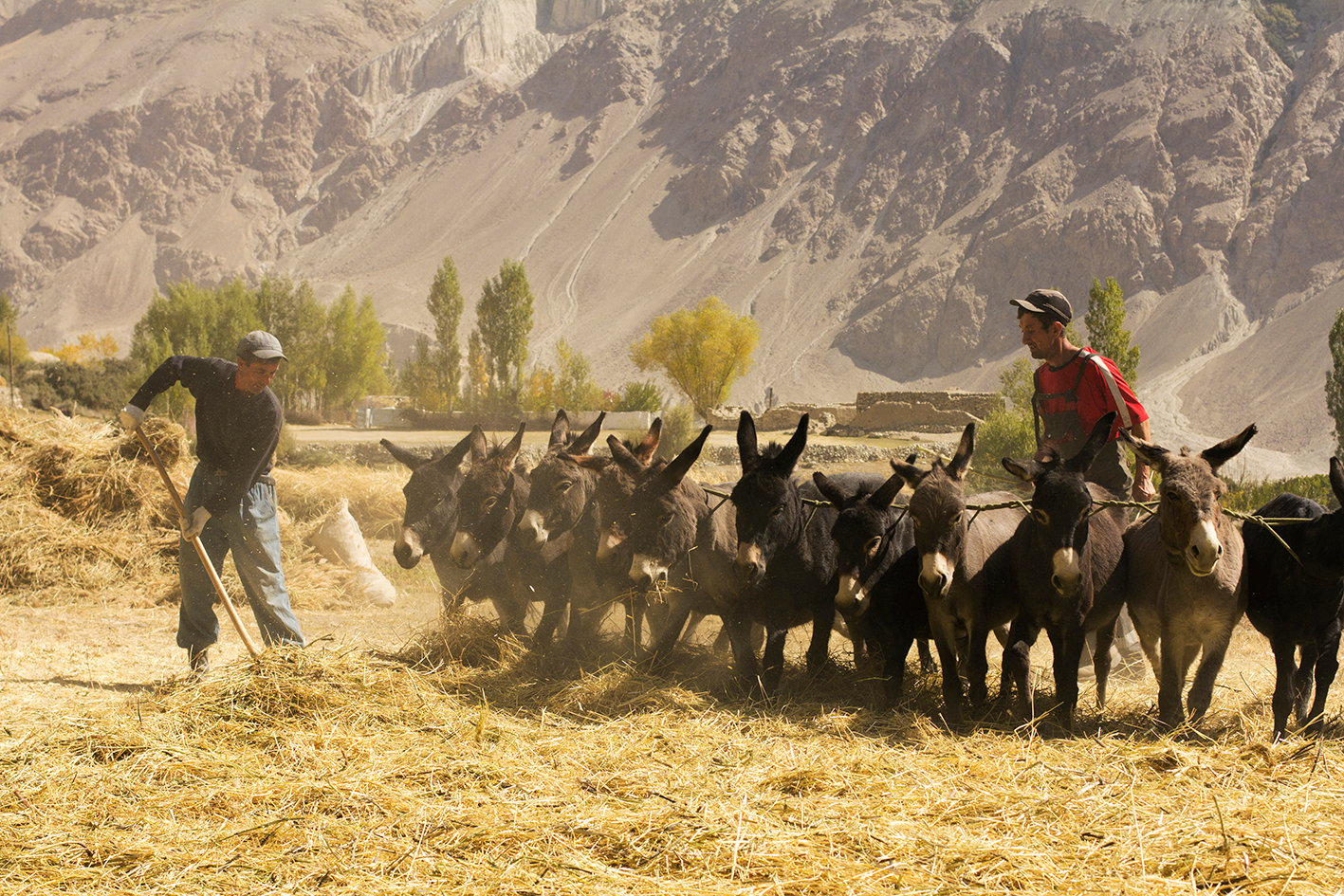
Copyright: Ashley Crowther (@ashleycrowtherorg) for EverydayClimateChange
We tend to take seasons for granted. Summer, monsoon, drought, and snowfall — we expect them to occur at certain times of the year and have shaped our lives, economies and environments around them. Now, climate change threatens this delicate balance and predictability. For some, this is not an immediate issue. But for farmers like these in Tajikistan’s Whakhan Valley, many uncertainties have surfaced due to the impact of climate change on seasonal weather patterns. They have no assurance that they will get enough snowfall over the winter to provide them with water over the summer growing period, threatening their food supply and livelihoods.
Preparing and assisting "at risk" regions to adapt to climate change is paramount to safeguard human life, biodiversity, and food security. After all, if you are what you eat, so is the climate!
27 April 2015: Boatmen on the River Nile in Cairo, Egypt.
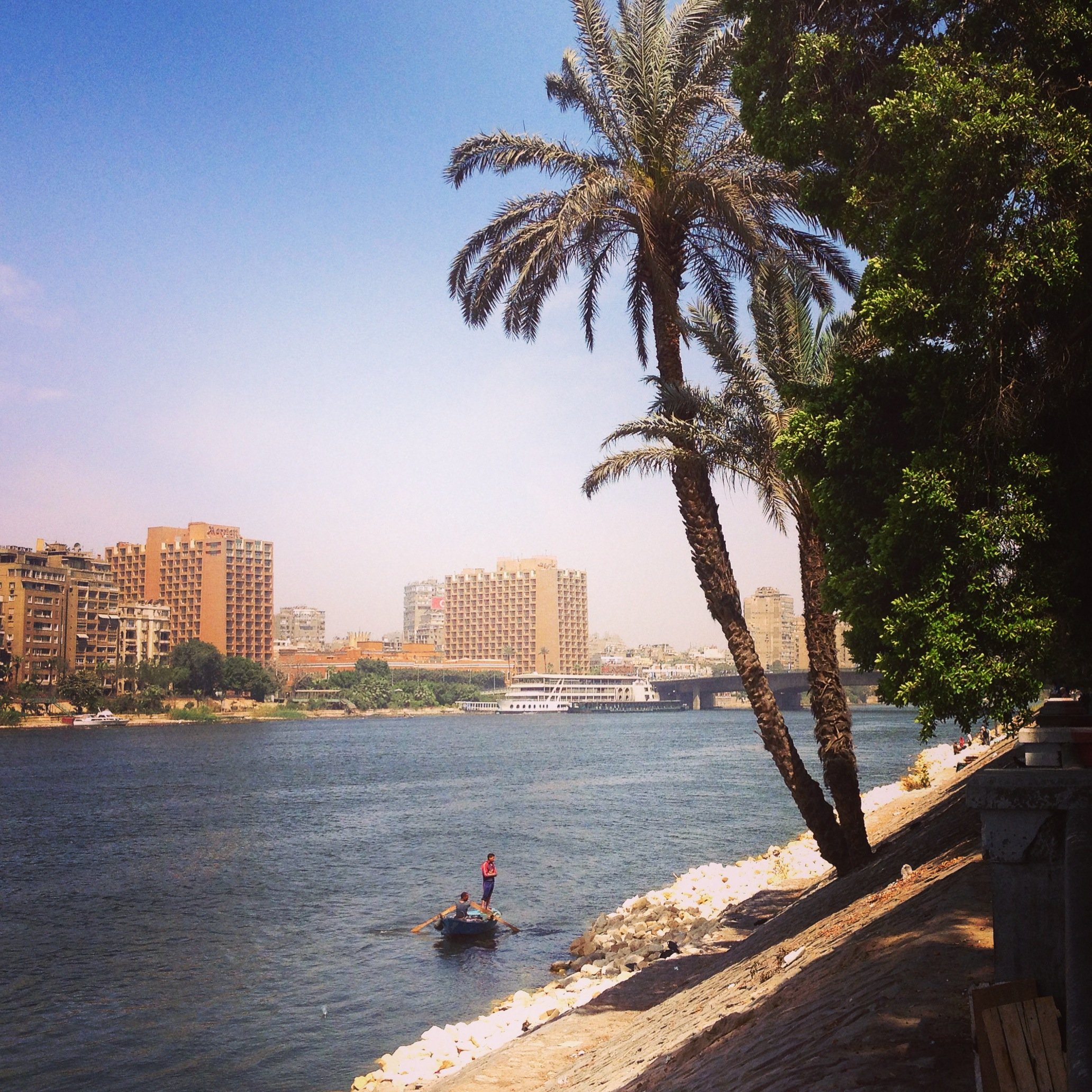
Copyright: Jeremy Sutton-Hibbert for EverydayClimateChange
The Nile delta in Egypt is a very flat and low-lying area, only a few metres above sea level. That places it at high risk from any rise in sea levels due to climate change.
Did you know that 13 of the 15 largest cities in the world rest on coastal plains? With the projection that global warming will cause sea levels to rise as much as 50cm over the next century, cities like Shanghai, Manila, Jakarta, and Dhaka will find themselves at the frontline of climate change impacts. Therefore, the global community needs to act decisively to limit global temperature rise to below 2 degrees celsius compared to pre-industrial levels- starting now.
As an individual, you can also play your part! Start by sharing this post to raise awareness among your network. Have other suggestions and ideas for climate action? Share your thoughts in the comments section below.
Our first weekly pick for April 2015: Chinese coal miners warm their hands over hot coals at a mine in the far western region of Xinjiang, China.

Copyright: Bernardo De Niz for EverydayClimateChange
China is the world's largest consumer and producer of coal, a major contributor to global emissions. This is why Earth Hour in China is focusing on spreading awareness and action on renewable energy. From school engagement programmes to innovative apps to showcase the use and success of renewable energy, WWF-China is using the Earth Hour platform to inspire people to make the shift to clean, green energy sources. The Earth Hour 2015 event in China was also held in the solar-powered Capital Museum in Beijing.
These images are from the highly regarded EveryDayClimateChange Instagram feed, founded by James Whitlow Delano.
Stay tuned for next week's pick on 15 June!
climate change, everydayclimatechange, images, daily
